
- STARTUP COURSE AND DOCUMENTS
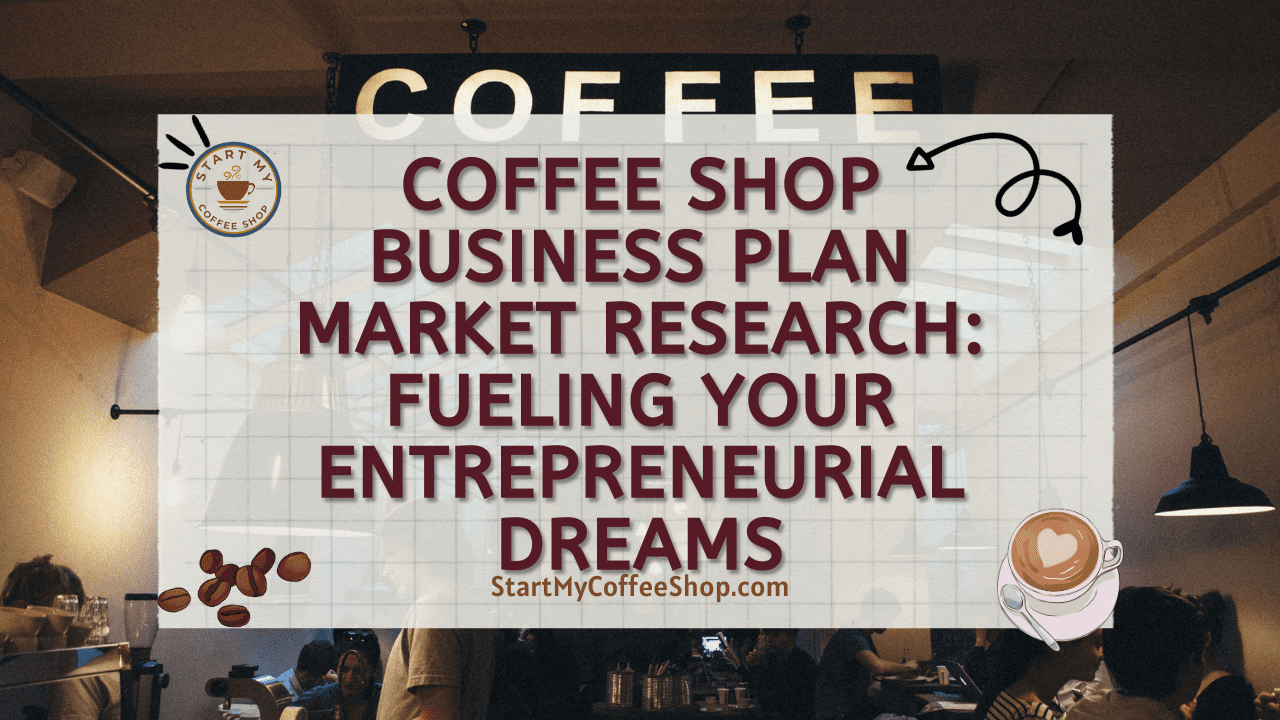

Coffee Shop Business Plan Market Research: Fueling Your Entrepreneurial Dreams
Though opening a coffee shop can be an exciting venture, meticulous preparation, and market research are necessary to assure its movement. A strong business plan is necessary, and detailed market research is an integral part of that plan.
Coffee shop business plan market research requires understanding the market, identifying your target customers, analyzing competitors, and evaluating location, pricing, and consumer trends to create a solid foundation for a coffee shop. Market research is a fundamental step in developing a coffee shop business plan.
I’ll discuss the value of market research for coffee shop enterprises in this article and offer some tips on how to carry it out well in order to create a killer business plan.
Table of Contents
Understanding the Market

Customers have a more sophisticated palate and a need for improved coffee experiences due to specialty coffee’s rising popularity. They look for coffee shops that have a wide selection of premium beans, professionally made drinks, and a distinctive atmosphere. A robust coffee culture has emerged due to this change in customer expectations, where coffee shops are now more than just places to grab a quick cup of joe.
However, this surge in demand has led to a highly competitive market. Coffee shop owners must navigate through a crowded landscape to establish their unique value proposition and carve out a loyal customer base. It is essential to offer a compelling blend of exceptional coffee, personalized service, inviting atmospheres, and innovative offerings to stand out from the competition.
By understanding the broader coffee shop market dynamics, including consumer preferences, emerging trends, and evolving expectations, entrepreneurs can better position themselves to meet the needs of discerning coffee enthusiasts. Armed with this knowledge, they can craft a business plan that leverages the market opportunities while differentiating their coffee shop to attract and retain customers in an increasingly competitive environment.
Read more about: Business Plan Presentation Coffee Shop: Pitch Perfect
Identifying Target Customers
When it comes to building a great coffee shop, a key aspect is the identification and understanding of your target customers. This process starts by defining your coffee shop’s niche, whether it’s a cozy neighborhood café that fosters a sense of community or a trendy espresso bar with a modern and upscale vibe. By clarifying your niche, you can align your offerings and create an atmosphere that resonates with your target audience.
To truly comprehend your target customers, it’s essential to consider various factors. Location plays a significant role as it influences the demographics of the area and the foot traffic your coffee shop will receive. Understanding the local community and its preferences is crucial for tailoring your menu, pricing, and overall concept.
Demographics, such as age, income level, and occupation, provide insights into the characteristics of your potential customers. This information helps you cater your offerings to their specific needs and preferences. Furthermore, psychographics, which includes interests, values, and lifestyle choices, allow you to delve deeper into understanding what your target customers value in a coffee shop experience.
Market Segmentation
Segmentation is a powerful tool that enables you to divide your target market into distinct groups based on specific characteristics. By doing so, you can tailor your offerings and marketing strategies to effectively meet the needs of each segment. In the coffee shop industry, there are several common segmentation factors that can be utilized to gain a deeper understanding of your customers.
One important factor to consider is age. Different age groups often have varying preferences when it comes to coffee consumption. For instance, younger demographics may lean towards specialty coffee and experimental flavors, while older generations may prefer traditional and familiar options. By identifying the age ranges within your target market, you can curate a menu and ambiance that cater to their tastes.
Lifestyle is another crucial segmentation factor. Some individuals may lead busy, on-the-go lifestyles, seeking quick and convenient coffee options, while others may prioritize a leisurely coffee experience, valuing ambiance and comfortable seating. Understanding the lifestyle choices of your target customers allows you to design your coffee shop’s offerings and services accordingly.
Preferences, such as the type of coffee, brewing methods, and additional menu items, also contribute to effective segmentation. Some customers may have a preference for espresso-based drinks, while others may enjoy pour-over or cold brew options. By tailoring your menu and offerings to suit the preferences of different segments, you can cater to a broader range of coffee enthusiasts.
Segmentation allows you to gain a deeper understanding of your target market, their specific needs, and their preferences. Armed with this knowledge, you can develop marketing campaigns that speak directly to each segment, craft targeted promotions, and create personalized experiences that resonate with different customer groups. Ultimately, segmentation empowers you to build stronger connections with your customers, foster loyalty, and drive the long-term growth of your coffee shop.
Competitor Analysis

Analyzing competitors is a vital aspect of market research when starting a coffee shop. Begin by identifying the existing coffee shops in your area and delve into a comprehensive study of their strengths, weaknesses, and market positioning. To gain firsthand insights, visit their establishments and immerse yourself in their ambiance, menu offerings, pricing, and customer experience.
By closely examining your competitors, you can uncover valuable information that will enable you to identify gaps in the market. Pay attention to areas where your competitors may be lacking or not fully meeting the needs of customers. This analysis will help you develop effective strategies to differentiate your coffee shop and offer a unique value proposition.
By understanding what your competitors are doing well, you can strive to match or exceed their strengths while also capitalizing on areas where they may fall short. This will allow you to carve out a distinctive space in the market and attract customers who are looking for something different or better.
Read more about: Business Plan Outline for Coffee Shop: A Caffeinated Business
Location Analysis
The significance of a location cannot be overstated when it comes to the improvement of a coffee shop. Conducting a comprehensive analysis of potential locations is essential to make an informed decision. Factors such as foot traffic, accessibility, nearby businesses, and competition should be carefully considered.
Foot traffic is a critical aspect to evaluate when choosing a location for your coffee shop. Look for areas with a consistent flow of people, such as busy streets, commercial districts, or near popular attractions. A higher footfall increases the potential customer base and the visibility of your coffee shop.
Accessibility is another crucial factor. Ensure that the location is easily reachable for your target customers, whether by public transportation or car. Convenient access encourages customers to visit your coffee shop regularly and increases the chances of attracting new customers.
Consider the surrounding businesses in the vicinity of the potential location. Are there complementary establishments that can drive traffic to your coffee shop? For example, being near offices, colleges, or gyms can attract professionals, students, or health-conscious individuals seeking a coffee break or a place to study.
Pricing and Financial Analysis
Start by examining the pricing strategies of other coffee shops in your area. Consider factors such as the quality of ingredients, level of service, and the uniqueness of your offerings. This analysis will help you gauge the market’s price range and position your coffee shop accordingly. While it’s important to remain competitive, also consider the value you offer to customers through exceptional products and experiences.
In addition to competitor analysis, conducting a thorough financial analysis is vital. Take into account the costs associated with running your coffee shop, including rent, equipment, staffing, and supplies. Understanding your overhead costs and profit margins will guide you in setting prices that cover expenses while ensuring profitability.
It’s important to strike a balance between offering value to customers and generating revenue for your coffee shop. Consider factors such as the perceived value of your products, customer willingness to pay, and your desired profit margins. Experimentation and periodic review of your pricing strategy will help you fine-tune and optimize your prices as market dynamics evolve.
Consumer Trends and Preferences

One area to focus on is brewing methods. Stay updated on the latest brewing techniques, such as pour-over, cold brew, or AeroPress, as they gain popularity among coffee enthusiasts. Offering a variety of brewing methods can cater to different taste preferences and provide a unique experience for your customers.
Alternative milk options have also become increasingly important due to changing dietary preferences and concerns about sustainability. Stay informed about the various non-dairy milk alternatives, such as almond, oat, soy, or coconut milk, and consider offering a range of options to accommodate different dietary needs.
Sustainability practices are another significant trend in the coffee industry. Consider sourcing coffee beans from sustainable and ethical suppliers, implementing eco-friendly packaging solutions, and promoting recycling and waste reduction initiatives.
The demand for organic and fair-trade coffee continues to grow as consumers prioritize ethical and responsibly sourced products. Stay knowledgeable about certifications and labels associated with organic and fair-trade coffee and consider incorporating these options into your menu to meet the preferences of socially conscious customers.
Read more about: Business Plan Proposal for Coffee Shop: A Coffee Lover’s Blueprint
Marketing and Promotions
Start by understanding your target audience and their preferred communication channels. Consider whether your customers are more active on social media platforms, rely on local advertising, or respond well to partnerships with other businesses. This knowledge will enable you to allocate your marketing resources wisely and tailor your messaging to resonate with your audience.
Social media has become a powerful tool for engaging with customers and promoting your coffee shop. Identify the platforms where your target audience is most active and develop a social media strategy that includes creating compelling content, interacting with customers, and running targeted advertising campaigns.
Local advertising is another effective avenue for reaching potential customers. Explore advertising options in local newspapers, magazines, radio stations, or through outdoor signage. By focusing on the local community, you can enhance brand visibility and attract customers in your immediate vicinity.
To increase your exposure and reach new client categories, think about forming collaborations with other companies. Collaboration with comparable companies, such as neighborhood bakeries or bookshops, can generate mutually advantageous chances for cross-promotion and brand exposure.
Research events and community activities that align with your coffee shop’s values and target audience. Participating in local festivals, farmers’ markets or charity events can help you build brand awareness, connect with the community, and create memorable experiences that leave a lasting impression on potential customers.
Market research is a fundamental step in developing a coffee shop business plan. By understanding the market, identifying your target customers, analyzing competitors, and evaluating location, pricing, and consumer trends, you can create a solid foundation for a great coffee shop. Remember to regularly update your market research to stay ahead of changing trends and ensure the continued growth of your business. With careful planning and thorough market research, your coffee shop can become a thriving destination for coffee enthusiasts and a beloved part of the community.
Frequently Asked Questions
Questions: how important is market research for a coffee shop business plan.
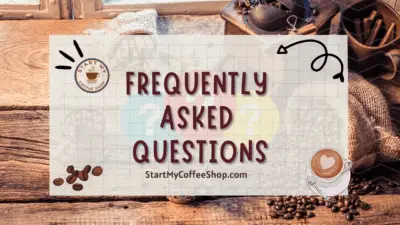
Answer: It provides valuable insights into the market, target customers, competition, pricing, and consumer trends. It helps entrepreneurs make informed decisions, identify opportunities, and develop strategies to ensure the long-term growth of their coffee shops.
Question: What are the key components of market research for a coffee shop business?
Answer: Market research for a coffee shop business includes understanding the overall coffee shop market, identifying target customers, conducting competitor analysis, analyzing potential locations, evaluating pricing dynamics, staying updated with consumer trends and preferences, and developing effective marketing and promotional strategies.
Question: How can competitor analysis benefit a coffee shop business?
Answer: By studying their market positioning, menu offerings, pricing, and customer experience, entrepreneurs can identify gaps in the market and develop strategies to differentiate their coffee shop, attract customers, and offer a unique value proposition.
To learn more on how to start your own coffee shop, check out my startup documents here.
Disclaimer: The information provided by StartMyCoffeeShop.com (“The Site”) is for general informational purposes only. All information on the Site is provided in good faith. However, we make no representation or warranty of any kind, express or implied, regarding the accuracy, adequacy, validity, reliability, availability, or completeness of any information on the Site. Under no circumstance shall we have any liability to you for any loss or damage of any kind incurred as a result of the use of the Site or Reliance on any information provided on the Site. Your use of the Site and reliance on any information on the Site is solely at your own risk. This blog post is for educational purposes only and does not constitute legal advice. Please consult a legal expert to address your specific needs. Terms and Conditions. ( https://startmycoffeeshop.com/terms-and-conditions/ )

Hi! I’m Shawn Chun
My adventure in coffee began when I first launched my first coffee shop back in the early 2000s. I had to figure out so many things on my own and to make it worse within 2 years of opening two large corporate coffee chains moved in just blocks away from me!
As I saw smaller and even some larger coffee shops in the neighborhood slowly lose customers to these giant coffee chains and slowly close up shop, I knew that I had to start getting creative…or go out of business.
I (like you may be) knew the coffee industry well. I could make the best latte art around and the foam on my caps was the fluffiest you have ever seen. I even had the best state-of-the-art 2 group digital Nuova Simonelli machine money could buy. But I knew that these things alone would not be enough to lure customers away from the name brand established coffee shops.
Eventually, through lots of trial and error as well as perseverance and creativity I did find a way to not only survive but also thrive in the coffee/espresso industry even while those corporate coffee chains stayed put. During those years I learned to adapt and always faced new challenges. It was not always easy, however, in the end, I was the sole survivor independent coffee shop within a 10-mile radius of my location. Just two corporate coffee chains and I were left after that year. All told the corporate coffee chains took down over 15 small independent coffee shops and kiosks and I was the last one standing and thriving.
Along the years I meet others with the same passion for coffee and I quickly learned that it is not only “how good a barista is” that makes a coffee shop successful, but the business side of coffee as well.
Hence why I started this website you are on now. To provide the tools and resources for up and coming coffee shop owners to gain that vital insight and knowledge on how to start a coffee shop successfully.
Stick around, browse through my helpful blog and resources and enjoy your stay! With lots of LATTE LOVE!
Share This Story, Choose Your Platform!
Related posts.

Best Ways to Implement Sustainable Practices in Your Coffee Shop

How to Host Events at Your Coffee Shop

Best Coffee Shop Loyalty Programs to Implement

Infusing Style and Substance: A Blueprint for Coffee Shop Design

Infusing Comfort and Charm: Small Coffee Shop Design Concepts

Complete Market Research Guide for Coffee Shops & Roasters
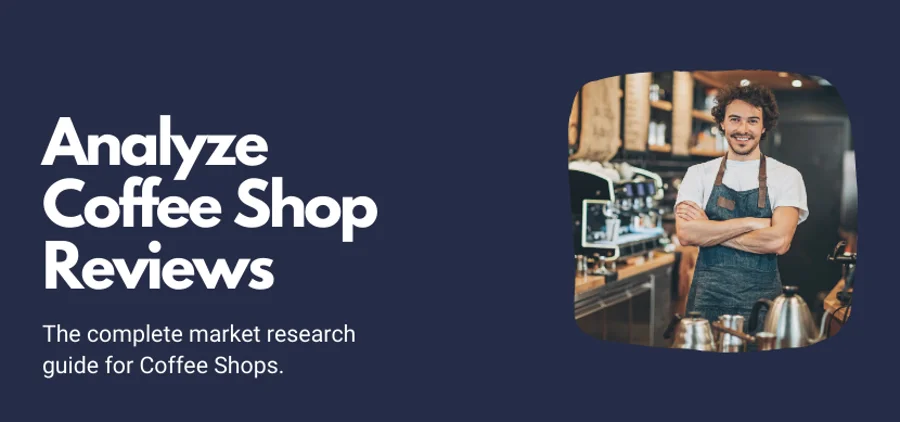
Customer feedback is important as it helps businesses understand customer needs and gain market insights. Coffee shops can meet customer expectations by taking customer feedback into account. Customers look at some essential factors when choosing a coffee shop. These can be coffee varieties, flavour, bean preferences and freshness along with pricing. They also pay attention to the excess of dessert options and good coffee. While drinking coffee, people either want to study or chat with people, so the interior design of coffee shops is among the selection criteria for customers. To establish or effectively manage a coffee shop, it is necessary to consider all these customer-related factors and analyze customer reviews.
I understand that doing market research can be very challenging. Despite the challenges, the success and growth of your business depends on understanding the customer. You can use Trustpilot for customer reviews while doing market research. On this site, you can filter the comments of a coffee shop based on star, date and language options. You can even look up the most common words. For example, let's look at the most common words in the coffee shop: "variety", "quality", "style", and "experience" . Although Trustpilot offers these filters for viewing reviews, it does not provide an overview of customer reviews. You must read all the comments, which would be a very long process.
There are many tools available from Trustpilot that receive and analyze customer reviews. Many of these tools could be more practical. Separate business processes, such as data collection and editing, even require coding knowledge for some. The solution I recommend is Kimola's free research tool. It doesn't even require a credit card and registration information, and you just need the link address of the cafe you want to analyze from Trustpilot. Kimola's research tool provides a convenient and effective solution for extracting and analyzing Trustpilot reviews.

Scraping and Examining Trustpilot Reviews
- Identify and collect the links to your competitors' Trustpilot profiles by searching for their names on Trustpilot.
- Visit the website https://kimola.com/scrape-and-analyze-trustpilot-reviews
- Paste the gathered Trustpilot profile links into the designated box provided by Kimola's tool.
- Click the "Start" button to initiate the analysis process.
- Once the analysis is completed, you can access the generated report. This report will contain valuable insights and information extracted from the Trustpilot reviews of your competitors.
Customer Feedback Analysis from Kimola's Free Research Tool
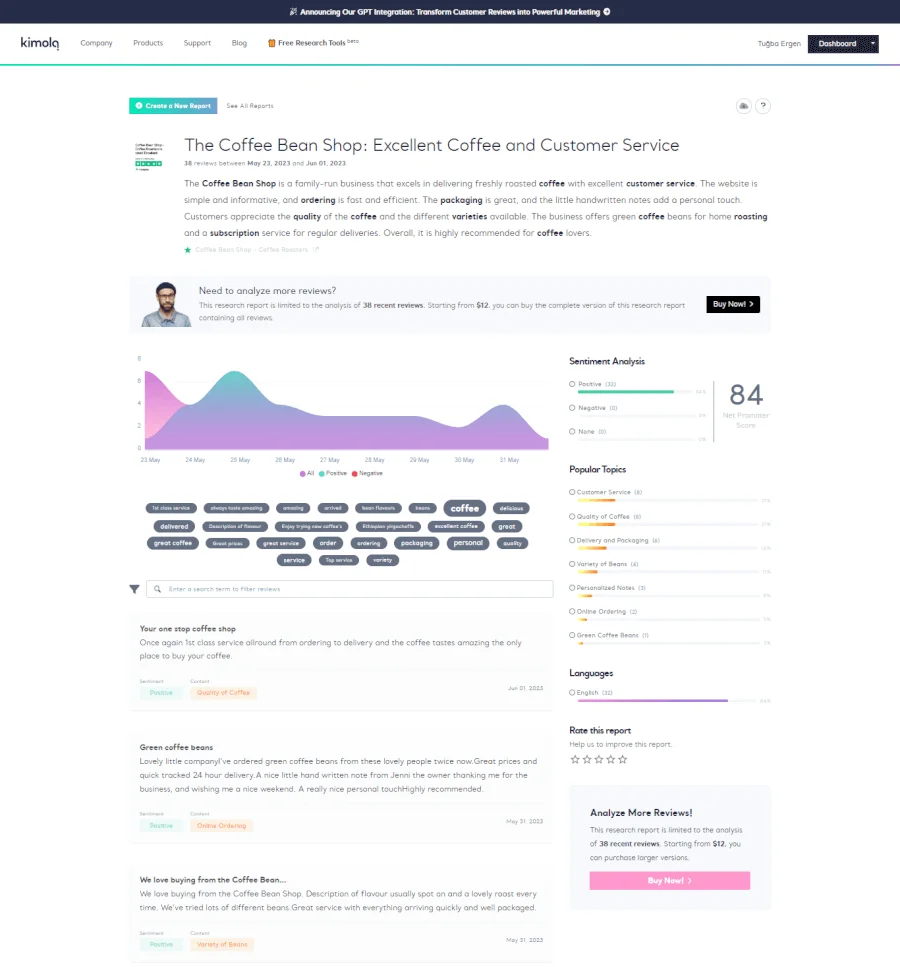
We gather global consumer research news and share them with 3,000+ marketing and research professionals worldwide.

Complete Market Research Guide for Furniture Stores
Learn how to analyze reviews of furniture stores on Trustpilot.

Complete Market Research Guide for Hair & Beauty Salons
Learn how to leverage customer feedback for your hair and beauty salon listed on Trustpilot.

Complete Market Research Guide For Hobby Stores
See how to scrape and analyze hobby store reviews on Trustpilot with one click to reveal customer insights.
Access all your Kimola products with a single credential.

Join 3,000+ marketing and research professionals from 80+ countries.
Fill out the form and one of our team members will contact you soon.
- Solutions Industry Gaming Automotive Sports and events Education Government Travel & Hospitality Financial Services Healthcare Cannabis Technology Use case NPS+ Communities Audience Contactless surveys Mobile LivePolls Member Experience GDPR Employee Experience Conjoint
- Resources Blog eBooks Survey Templates Case Studies Training Help center
- Desktop Created with Sketch.
- Mobile Created with Sketch.
Related templates and questionnaires
- Sample Questions
- Sample Reports
- Survey Logic
- Integrations
- Professional Services
- Survey Software
- Customer Experience
- Communities
- Polls Explore the QuestionPro Poll Software - The World's leading Online Poll Maker & Creator. Create online polls, distribute them using email and multiple other options and start analyzing poll results.
- Research Edition
- Survey Templates
- Case Studies
- Coronavirus Resources
- Qualtrics Explore the list of features that QuestionPro has compared to Qualtrics and learn how you can get more, for less.
- SurveyMonkey
- VisionCritical
- Market Research Survey Software Real-time, automated and advanced market research survey software & tool to create surveys, collect data and analyze results for actionable market insights.
- Employee Survey Software Employee survey software & tool to create, send and analyze employee surveys. Get real-time analysis for employee satisfaction, engagement, work culture and map your employee experience from onboarding to exit!
- Customer Survey Software Robust, automated and easy to use customer survey software & tool to create surveys, real-time data collection and robust analytics for valuable customer insights.
- Community Survey Software Use the community survey software & tool to create and manage a robust online community for market research. Collect community feedback and insights from real-time analytics!
- Web Survey Software Powerful web survey software & tool to conduct comprehensive survey research using automated and real-time survey data collection and advanced analytics to get actionable insights.
- Mobile Survey Software Leverage the mobile survey software & tool to collect online and offline data and analyze them on the go. Create and launch smart mobile surveys!
- Business Survey Software Powerful business survey software & tool to create, send and analyze business surveys. Get actionable insights with real-time and automated survey data collection and powerful analytics!
- Enterprise Survey Software Real time, automated and robust enterprise survey software & tool to create surveys. collect data and analyze responses to get quick actionable insights.
- Email Survey Software Robust email survey software & tool to create email surveys, collect automated and real-time data and analyze results to gain valuable feedback and actionable insights!
- SMS Survey Software Use the power of SMS to send surveys to your respondents at the click of a button. SMS survey software and tool offers robust features to create, manage and deploy survey with utmost ease.
- Offline Surveys
- Customer Satisfaction Surveys
- Net Promoter Score (NPS) Learn everything about Net Promoter Score (NPS) and the Net Promoter Question. Get a clear view on the universal Net Promoter Score Formula, how to undertake Net Promoter Score Calculation followed by a simple Net Promoter Score Example.
- Conjoint Analysis
- GDPR & EU Compliance
- Likert Scale Complete Likert Scale Questions, Examples and Surveys for 5, 7 and 9 point scales. Learn everything about Likert Scale with corresponding example for each question and survey demonstrations.
- Executive Team
- Advisory Board
- Testimonials
- In the news
QuestionPro in your language
- Encuestas Online
- Pesquisa Online
- Umfrage Software
- Сервис опросов
- برامج للمسح
- Logiciel d'enquête
Awards & certificates
The experience journal.
Find innovative ideas about Experience Management from the experts
- Privacy Statement
- Terms of Use
- Cookie Settings
Creating a survey with QuestionPro is optimized for use on larger screens -
Though you're welcome to continue on your mobile screen, we'd suggest a desktop or notebook experience for optimal results.
Do you want to create free survey about:
Coffee Shop Survey?
Or maybe something else?
or use this template:
Coffee Shop Survey
Discover the importance of the Coffee Shop Survey in improving customer experience and enhancing coffee businesses.
Would you like to work on this survey?
Startquestion is a free survey platform which allows you to create, send and analyse survey results.
How Coffee Shop Surveys Help Improve Customer Experience
In today's competitive coffee industry, understanding customer preferences and improving the overall experience is crucial for success. The Coffee Shop Survey provides valuable insights into customer behavior, preferences, and satisfaction levels. With a goal to gather customer feedback, this survey offers a comprehensive range of questions covering various aspects of the coffee shop experience. From surveying how often customers visit coffee shops to their favorite coffee types, seating preferences, and dietary restrictions, this questionnaire covers it all. By utilizing single choice, multiple choice, and open-ended questions, the survey captures a diverse range of responses, enabling coffee shop owners to make data-driven decisions to enhance their offerings. As the article dives into the different questions, it shows the variety and depth of customer preferences when it comes to coffee. Each question addresses a specific aspect of the coffee shop experience, ensuring an in-depth understanding of customer needs and desires. The Coffee Shop Survey is categorized under the 'Customer Feedback' category. It forms an integral part of market research for coffee businesses, aiding them in tailoring their offerings and marketing strategies to better serve their target audience. In conclusion, the Coffee Shop Survey plays a crucial role in shaping the customer experience at coffee shops. By gathering feedback and preferences through its thoughtfully designed questions, coffee shop owners can create a more satisfying and enjoyable experience for their customers, ultimately boosting their business success.
.webp)
Advanced Research
How to Calculate Your Sample Size Using a Sample Size Formula

November 25, 2021
Research 101
Maria Noesi
100 Open-Ended Survey Questions for Effective Consumer Research
Consumer research surveys are an impactful way to gain valuable customer insights. Here is a list of 100 open-ended survey questions to get you started.

March 22, 2024
Market Research
Because we live in a globalized economy, market trends and customer preferences constantly morph and change over time. This only leaves brands with (open-ended) questions about their customers.
Among the constant waves of competition and increasing power of choice given to consumers, a company’s ability to maintain an agile strategy with this added pressure will determine its rate of survival over the next decade.
With that in mind, conducting effective and impactful market research is now more essential to basic business survival than at any point in history.
That's why we put together this epic list of 100 open-ended survey questions for market research.

Should I Use Closed-Ended or Open-Ended Survey Questions?
Often, the first step in collecting consumer data is developing a strong customer survey that has high response rates. The type of questions you use would then be dependent on the type of insights you are looking to collect.
A close-ended question can be highly effective in helping you achieve quantitative data of your customers. For example, if you were conducting research on condiment usage patterns, multiple answer or rating scale questions can help you quickly understand the percentage of users that consume cilantro on a weekly basis.
On the other hand, open-ended questions can help you gain qualitative data and customer insights . For example, as part of the same research, open-ended questions can you help collect free form verbatims on what difficulties survey respondents face when they cook with spices.
What is an example of an Open-Ended Survey Question?
Good survey questions are built with specific insights in mind. Within the world of market research, we believe that strong qualitative survey questions can fall under five broad categories:
- Customer Behavior: Understanding general consumer trends and purchase behavior.
- Customer Feedback: Understanding what customers feel about your products and services.
- Concept Testing: Understanding what customers feel about a new concept for a product or feature.
- Marketing: Understanding the effectiveness of your marketing and advertising campaigns.
- Competitive Analysis: Understanding how your brand and product stand up against your competitors.
Implementing the appropriate open-ended questions in a survey helps you collect the most relevant insights to your needs. But what are the different types of questions and response options your company can use to collect the strongest survey data?
Customer Behavior Survey Questions
What does the customer journey look like for your consumers? What are some of the key pain points they face? Use these questions to gain better insights into those behaviors and preferences.
- What solutions did you try before using our product?
- When you started using our product, what were you thinking about?
- How do you typically find information about this type of product?
- What websites do you use to discover new products?
- What do you research about a product before purchasing it?
- What type of product do you research the most before purchase?
- What is the biggest difficulty you face when purchasing this type of product?
- How does Product X make you feel?
- How have you tried to solve Problem Y?
- What are the main challenges you are currently facing without a product like Product X?
- What persuaded you to [action] today?
- What is stopping you from [action] today?
- Now that you’ve solved Problem Y, what’s next?
- What influences you to purchase from a store in person?
- What influences you to purchase a product online?
- What deters you from purchasing a product online?
- What discourages you from purchasing a product in-store?
- What is your preferred brand of this product?
- At what point do you re-purchase this product type?
- What additional product are you likely to purchase alongside this product?
- How do you feel before purchasing this product?
- How do you feel immediately after purchasing this product?
- What factors determine your budget for this product?
Customer Feedback Survey Questions
Customer feedback management has a bad reputation for existing in quantitative scales of 1 to 5 and smiley faces of measurement delivered via cold email. Whether a customer’s feedback for your product or service is positive or not, this type of data collection will likely not give your company the feedback you want. Instead, try a few of these open-ended questions to collect quick, meaningful data.
- Follow Up: Why do you like using that feature?
- Follow Up: What makes you say that?
- What surprised you about using this product?
- What annoys you about this product?
- What problem does our product solve for you?
- How well does our product solve your problem?
- What part of our product is easy to use?
- What were the main difficulties you faced when using our product?
- How could we have helped you better use our product?
- If you could change one thing about our product, what would you change?
- What other features would you have liked to see on this product?
- Describe how you feel about our product.
- How can we improve your general experience with the company?
- In what situations do you use our product?
- If someone asked you about this product, what would you say to them?
- What is the primary benefit that you have received from using our product?
- Who would you recommend our product to?
- Describe your experience with our customer service team.
- What is the main factor that influences your decision to switch brands?
- How does past experience influence your decision to purchase from a brand?
- What do you expect from customer service after purchasing a product?
- What are your standards of quality when purchasing similar products?
- How do you prefer that a customer service team handles your complaints?
- What celebrity can you see endorsing or representing this product?
- Describe your purchasing process for this type of product.
- What influences your decision to purchase a new product?
- What was disappointing about your last experience with us?
- What was delightful about your last experience with us?
Concept Testing Survey Questions
Your company can collect data on a variety of types of customer feedback - and you don’t have to wait until after a product’s launch. Gauge customer interest for new products or features by writing a survey that measures perception, usage, tone, and experience before the concept ever reaches fruition. Use these questions to launch your inquisition into a new concept.
- How would you use this new feature?
- Follow Up: Why don’t you like that part of the feature?
- What considerations do you have when deciding on a version of the product?
- Among these different versions of the product, why did you decide on _____?
- How does this new feature make you feel?
- What excites you about this new feature?
- Follow Up: Why did you answer that way?
- If you had a magic wand and could have any new feature that you wanted on this product, what would it be?
- Have you seen something similar to this feature elsewhere?
- How do you think this new feature will improve your experience?
- How much would you expect to pay for this product?
- How do you envision incorporating this product into your daily life?
- Describe why this product is innovative.
- Describe why this product is not so innovative.
- At what stage of development do you think this product is at?
Marketing Survey Questions
Qualitative research is not exclusive to product development and concept testing. Surveys can also be used to understand the customer and consumer perceptions of marketing and advertising campaigns. These questions will help your company better understand external perceptions of your product.
- What do you think about our product’s story?
- What originally attracted you to our product?
- What do you like best about the messaging we use to promote our product?
- How would you explain our product to a friend, family member, or colleague?
- In one line, describe our product.
- What communication channels would you prefer we use?
- What supplementary content would help you use our product?
- Where exactly did you first hear about us?
- What companies or products do you perceive as our competitors?
- How does our messaging stand out from the competition?
- Who do you think uses our product?
- Which product attributes are most important to you?
- What would you improve about the product description?
- Write a one-sentence description of this product.
- How could our brand be more honest and transparent?
- What charity pairs well alongside our product?
- How could our product be more tailored to you?
- What does our product design make you feel?
- What does the product design remind you of?
Competitive Analysis Survey Questions
Although competitors come up in a variety of conversations with customers, asking specific competitive analysis questions is your time to dig deeper into your market share and potentially obtain internal information from competing companies.
- How would you feel if you couldn’t use our product?
- What other solutions have you considered?
- Which other options did you consider before choosing our product?
- Why did you choose our product rather than a competitor’s?
- What do we do better than other companies in this field?
- Who should we try and learn from?
- What would you use as an alternative if our product was no longer available?
- What are the first three brands in this category that come to your mind?
- In your opinion, what could we do to stand out from the competition?
- In the past three months, what have you heard about our brand?
- How would you describe your overall opinion of our brand?
- Do you have any additional comments or feedback for us?
- What could we have done to get a 10/10 today?
So you’ve developed a strong set of questions. What’s next? Check out the next step in our guide to writing better online surveys or discussion guides .

Multi-Language Conversations: Unlocking Global Research for All

Rethinking insights: The rise of conversational research

From Surveys to AI: The Evolution of Employee Listening
Stay up-to date..
Stay ahead of the curve. Get it all. Or get what suits you. Our 101 material is great if you’re used to working with an agency. Are you a seasoned pro? Sign up to receive just our advanced materials.

Get insights in your inbox . Sign up to stay up to date on the latest research tactics and breakthroughs.

©All Rights Reserved 2024. Read our Privacy policy
No data capture tricks. No bull SEO content for ranking. Just good, solid, honest, research ed.
By entering your email address, you agree to receive marketing communications in accordance with our privacy policy.

Request a demo
Dive Deeper
About NCA | Newsroom | Partner with NCA | Blog | Careers
NCA Coffee Market Research
Get the information your business needs to succeed - from consumer insights to emerging coffee market trends.
NCA Resources’ Terms & Conditions
National Coffee Association Market Research Publications:
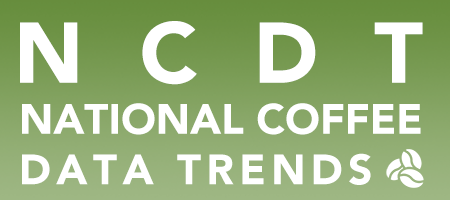
national coffee data trends 2024
The NCDT is the coffee industry standard report for tracking US consumer behaviors and attitudes.
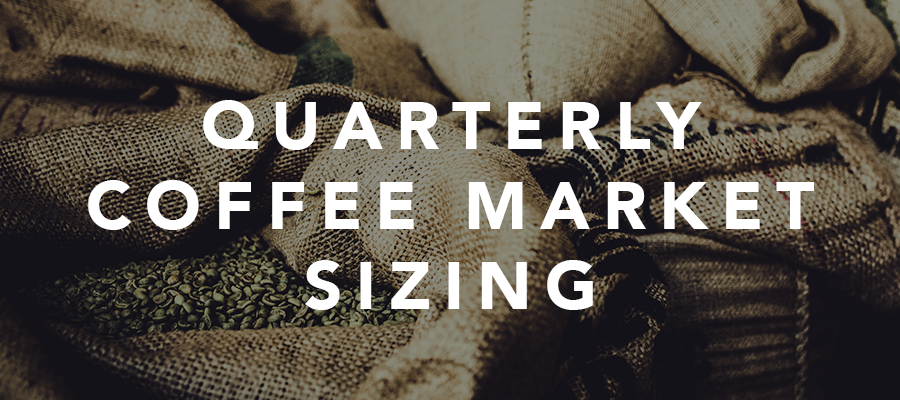
StudyLogic - NCA Market Research PARTNER
NCA Member Exclusive - Quarterly Market Sizing
Learn more about Customized Coffee Data, Quarterly Market Sizing, and Scorecard Reports
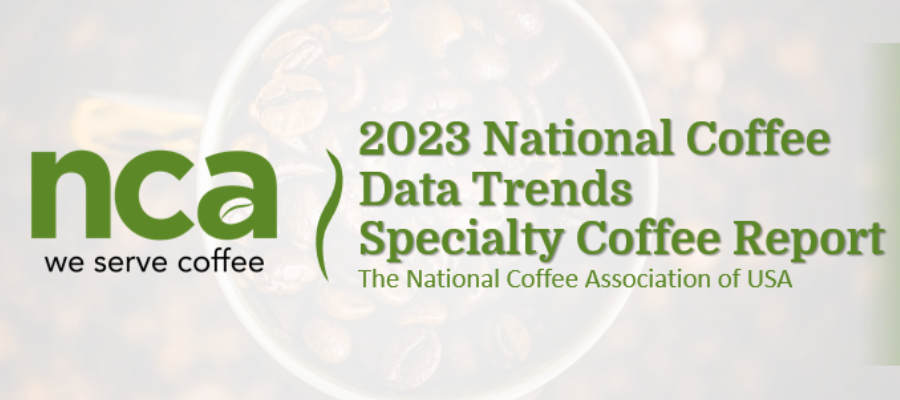
NCDT 2023 Specialty Coffee Report
Who's drinking specialty in the age of covid-19? How have habits and attitudes changed? Which areas of specialty are experience growth, and which might be key to retail coffee's recovery?
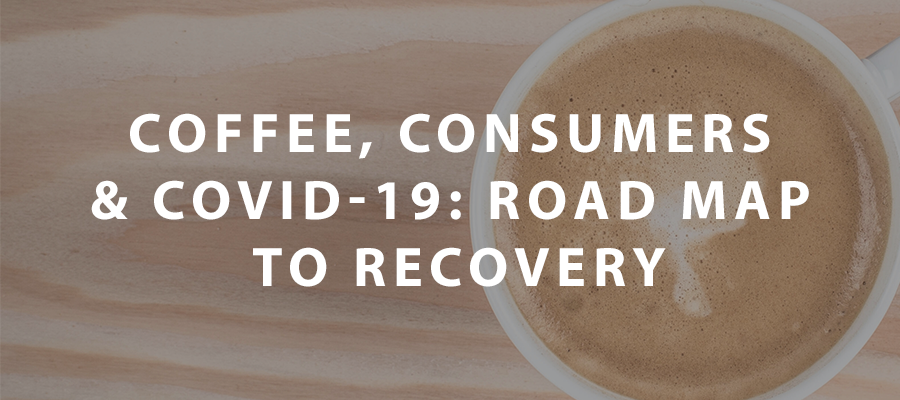
Coffee, Consumers & Covid-19: Road Map to Recovery
Chart a course through the pandemic with this first-of-its-kind, Members-only report -- the latest addition to the expanding NCDT Market Research Series.
NCA Member Discount

Swipe Right For Market Research
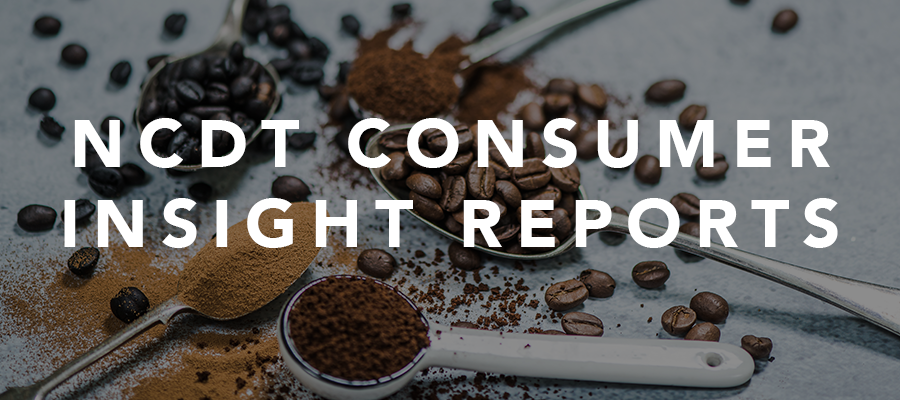
ncdt consumer insight reports
Now exclusively for NCA Members
Get targeted, in-depth insights into key issues on Single-Serve, Ethnicity & Gender, Cold Brew & RTD, Gen Z, Coffee Claims, In/Out-of-Home, Gourmet, Coffee & Health, Coffee Brewing, At Work , and Tea.
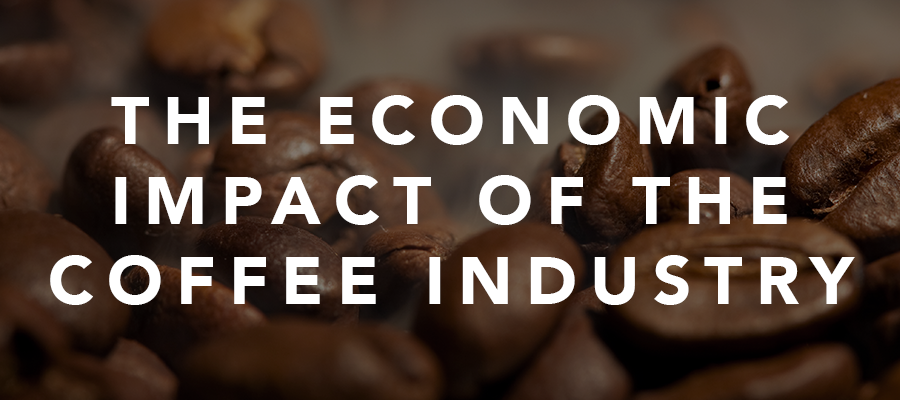
The Economic Impact of the US Coffee Market
NCA Industry Research
Past NCA Market Research Reports
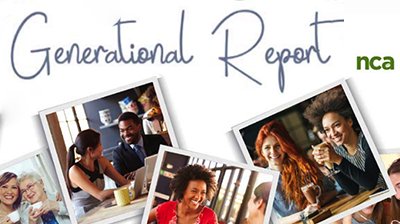
Generational Report
For the first time ever, we've analyzed the latest coffee consumption data along generational lines - and it turns out, age is more than just a number.
Other Sources: Facts & Stats

ICO Global Imports, Exports, and Consumption
The International Coffee Organization compiles information from governments to provide information on coffee prices, trade, production, and consumption.
USDA World Markets and Trade
The United States Department of Agriculture’s latest official data on U.S. and global trade, production, consumption and stocks, as well as analysis of developments affecting world trade in coffee.
USITC Current US Trade Data
The United States International Trade Commission Interactive Tariff and Trade Dataweb can be queried to obtain historical and up-to-date statistics on trade by HTS (harmonized tariff schedule) numbers. The code for coffee queries is 0901, with subcodes for specific classifications. (Free account registration required)
More: USITC
THE FIRST PULL

FAQs: Cold Brew
Nca member benefits.

Root out friction in every digital experience, super-charge conversion rates, and optimize digital self-service
Uncover insights from any interaction, deliver AI-powered agent coaching, and reduce cost to serve
Increase revenue and loyalty with real-time insights and recommendations delivered to teams on the ground
Know how your people feel and empower managers to improve employee engagement, productivity, and retention
Take action in the moments that matter most along the employee journey and drive bottom line growth
Whatever they’re are saying, wherever they’re saying it, know exactly what’s going on with your people
Get faster, richer insights with qual and quant tools that make powerful market research available to everyone
Run concept tests, pricing studies, prototyping + more with fast, powerful studies designed by UX research experts
Track your brand performance 24/7 and act quickly to respond to opportunities and challenges in your market
Explore the platform powering Experience Management
- Free Account
- For Digital
- For Customer Care
- For Human Resources
- For Researchers
- Financial Services
- All Industries
Popular Use Cases
- Customer Experience
- Employee Experience
- Net Promoter Score
- Voice of Customer
- Customer Success Hub
- Product Documentation
- Training & Certification
- XM Institute
- Popular Resources
- Customer Stories
- Artificial Intelligence
Market Research
- Partnerships
- Marketplace
The annual gathering of the experience leaders at the world’s iconic brands building breakthrough business results, live in Salt Lake City.
- English/AU & NZ
- Español/Europa
- Español/América Latina
- Português Brasileiro
- REQUEST DEMO
- Experience Management
- Market Research Questions
Try Qualtrics for free
Market research questions: what to ask and how.
9 min read Whether you’re looking for customer feedback, product suggestions or brand perception in the market, the right market research questions can help you get the best insights. Learn how you can use them correctly and where to begin.
What is market research?
Market research (also called marketing research) is the action or activity of gathering information about market needs and preferences. This helps companies understand their target market — how the audience feels and behaves.
For example, this could be an online questionnaire , shared by email, which has a set of questions that ask an audience about their views. For an audience of target customers, your questions may explore their reaction to a new product that can be used as feedback into the design.
Why do market research?
When you have tangible insights on the audience’s needs, you can then take steps to meet those needs and solve problems. This mitigates the risk of an experience gap – which is what your audience expects you deliver versus what you actually deliver.
In doing this work, you can gain:
- Improved purchase levels – Sales will improve if your product or service is ticking all the right buttons for your customers.
- Improved decision making – You can avoid the risk of losing capital or time by using what your research tells you and acting with insights.
- Real connection with your target market – If you’re investing in understanding your target audience, your product and service will more likely to make an impact.
- Understand new opportunities – it might be that your research indicates a new area for your product to play within, or you find potential for a new service that wasn’t considered before.
Get started with our free survey maker
Who do you ask your questions to?
Who to target in your market research is crucial to getting the right insights and data back. If you don’t have a firm idea on who your target audiences are, then here are some questions that you can ask before you begin writing your market research questions:
- Who is our customer currently and who do we want to attract in the future?
- How do they behave with your brand?
- What do they say, do and think?
- What are their pain points, needs and wants?
- Where do they live? What is the size of our market?
- Why do they use us? Why do they use other brands?
We’ve put together some questions below (Market research questions for your demographics) if you wanted to reach out to your market for this.
With the answers, you can help you segment your customer market, understand key consumer trends , create customer personas and discover the right way to target them.
Market research goals
Give yourself the right direction to work towards.There are different kinds of market research that can happen, but to choose the right market research questions, figure out your market research goals first.
Set a SMART goal that thinks about what you want to achieve and keeps you on track. SMART stands for Specific, Measurable, Attainable, Relevant and Timely. For example, a good SMART business goal would be to increase website sales for a top product by 10% over a period of 6 months.
You may need to review some strategic business information, like customer personas and historical sales data, which can give you the foundation of knowledge (the ‘baseline’) to grow from. This, combined with your business objectives, will help you form the right SMART targets tailored to your teams.
Types of market research questions
Now that you have your SMART target, you can look at which type of market research questions will help you reach your goal. They can be split into these types:
- For demographics
- For customers
- For product
Market research questions for your demographics
Demographic information about your customers is data about gender, age, ethnicity, annual income, education and marital status. It also gives key information about their shopping habits.
Here are some questions you can ask in your market research survey:
- What is your age / gender / ethnicity / marital status?
- What is the highest level of education you have achieved?
- What is your monthly income range?
- What methods of shopping do you use?
- What amount do you spend on [product/brand/shopping] each month?
- How regular do you shop for [product/brand]?
Learn more about the demographic survey questions that yield valuable insights .
Market research questions for your customer
These questions are aimed at your customer to understand the voice of the customer — the customer marketing landscape is not an one-way dialogue for engaging prospects and your customer’s feedback is needed for the development of your products or services.
- How did we do / would you rate us?
- Why did you decide to use [product or service]?
- How does that fit your needs?
- Would you recommend us to your friends?
- Would you buy from us again?
- What could we do better?
- Why did you decide to shop elsewhere?
- In your opinion, why should customers choose us?
- How would you rate our customer experience?
Learn more about why the voice of the customer matters or try running a customer experience survey.
Market research questions for your product
These questions will help you understand how your customers perceive your product, their reactions to it and whether changes need to be made in the development cycle.
- What does our [product or service] do that you like or dislike?
- What do you think about [feature or benefit]?
- How does the product help you solve your problems?
- Which of these features will be the most valuable / useful for you?
- Is our product competitive with other similar products out there? How?
- How does the product score on [cost / service / ease of use, etc.]?
- What changes will customers likely want in the future that technology can provide?
There are also a set of questions you can ask to find out if your product pricing is set at the right mark:
- Does the product value justify the price it’s marketed at?
- Is the pricing set at the right mark?
- How much would you pay for this product?
- Is this similar to what competitors are charging?
- Do you believe the price is fair?
- Do you believe the pricing is right based on the amount of usage you’d get?
Have you tried a pricing and value research survey to see how much your target customers would be willing to pay?
Market research questions for your brand
How does the impact of your products, services and experiences impact your brand’s image? You can find out using these questions:
- What do you think about our brand?
- Have you seen any reviews about us online? What do they say?
- Have you heard about our brand from friends or family? What do they say?
- How likely are you to recommend our brand to a friend?
- Have you read the testimonials on our own channels? Did they have an impact on your decision to purchase? How?
- When you think of our brand, what do you think/ feel / want?
- How did you hear about us?
- Do you feel confident you know what our brand stands for?
- Are you aware of our [channel] account?
Learn more about brand perception surveys and how to carry them out successfully.
How to use market research questions in a survey
For the best research questionnaires, tailoring your market research questions to the goal you want will help you focus the direction of the data received.
You can get started now on your own market research questionnaire, using one of our free survey templates, when you sign up to a free Qualtrics account.
Drag-and-drop interface that requires no coding is easy-to-use, and supported by our award-winning support team.
With Qualtrics, you can distribute, and analyse surveys to find customer, employee, brand, product, and marketing research insights.
More than 11,000 brands and 99 of the top 100 business schools use Qualtrics solutions because of the freedom and power it gives them.
Get started with our free survey maker tool
Related resources
Market intelligence 10 min read, marketing insights 11 min read, ethnographic research 11 min read, qualitative vs quantitative research 13 min read, qualitative research questions 11 min read, qualitative research design 12 min read, primary vs secondary research 14 min read, request demo.
Ready to learn more about Qualtrics?
- Mobile Forms
- INTEGRATIONS
- See 100+ integrations
- FEATURED INTEGRATIONS
- See more Integrations
- See more CRM Integrations

- See more Storage Integrations
- See more Payment Integrations

- See more Email Integrations
- Jotform Teams
- Enterprise Mobile
- Prefill Forms
- HIPAA Forms
- Secure Forms
- Assign Forms
- Online Payments
- See more features
- Multiple Users
- Admin Console
- White Labeling
- See more Enterprise Features
- Contact Sales
- Contact Support
- Help Center
- The Ultimate Guide to Automating Your Data NEW
- Jotform Academy
Get a dedicated support team with Jotform Enterprise.
- Sign Up for Free
- Coffee Survey
A coffee survey is a customer satisfaction survey that asks customers for feedback on coffee shops. Use a coffee survey to connect with customers about how you can serve them better while boosting your reputation! Simply customize the questions to match your coffee shop — then embed the coffee survey on your website, share it with a link, or have customers fill it out in person on your tablet or computer. You can even pull in coffee shop photos or logos to personalize the coffee survey.
Additionally, if you would also like to archive survey responses in other accounts that are already used such as Google Drive, Dropbox, Box, Airtable, etc., you can easily integrate your form with 100+ popular apps to automatically sync. Collect feedback fast with a free online Coffee Survey. All can be achieved without coding!
More templates like this
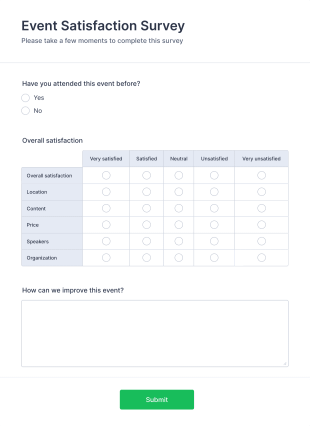
Event Satisfaction Survey Form
If you want to improve your upcoming event, you can get suggestions from participants by using this event satisfaction survey template. This sample feedback form allows gathering overall satisfaction by categorizing the event services. These categories are location, content, price, speakers, organization.If you are looking for creating your own survey from scratch, you can get started with the survey maker now for free!

Online Interview Questionnaire Form
An online interview questionnaire form is used by organizations to help them get important information from their interviewees. Whether you’re an insurance company, a hospital, or a company that hires individuals in various roles, use this form to gather more information from applicants applying to jobs. This Online Interview Questionnaire Form is also an additional way to confirm the information you have received from your applicants. Just customize the template, embed the form on your website, and watch as applicants send you the information you need.This online interview questionnaire form allows you to select the responses you need, and then convert the responses into easily downloadable or printable PDFs. If you’d like to automate the questions or the responses, you can use Jotform’s integration options with 100+ other powerful apps, including Google Drive, Dropbox, and Slack. You can also personalize your online interview questionnaire form to fit your business’s branding. Add your logo, change the background, or add more form fields to your liking. You can even send questions to your own CRM automatically if you use Jotform Report Builder! Make the most of your job applications with a free online interview questionnaire form.

Market Research Survey
A market research survey is a questionnaire used by companies to collect information about their customers and their market. Here's a quick market research form that focuses on a few demographic statistics. This survey form will ask for the respondents' age, gender, household income, and educational attainment. The survey format is multiple-choice, giving your respondents an easy way of completing it in a few minutes. Use this market research template and use the collected submission data to your advantage. If you want to create your survey from scratch, you can get started with the survey maker now!Use our free Market Research Survey template for your business — it’s easy to customize, fast to set up, and perfect for collecting info from your customers and fans. Simply add your company logo, change the text and colors, and you’re on your way! If you’d like to embed this survey on your website, you can sync it to a website builder. If you’re looking to collect more information than the Market Research Survey provides, you can use our Form Builder to add more fields. Collect all of the data you need to make decisions with a free Market Research Survey.
- Form Templates /
- Survey Templates /
Survey Templates
If you want to improve your upcoming event, you can get suggestions from participants by using this event satisfaction survey template. This sample feedback form allows gathering overall satisfaction by categorizing the event services. These categories are location, content, price, speakers, organization.
An Online Interview Questionnaire Form is a form template designed to help organizations gather important information from their interviewees.
A Market Research Survey is a form template designed to collect important information about customers and the overall market for companies.

Employee Satisfaction Survey
Get to know your employees with a free online survey. Collect responses from any device. Customize in minutes with no coding. Sync responses to 100+ popular apps.
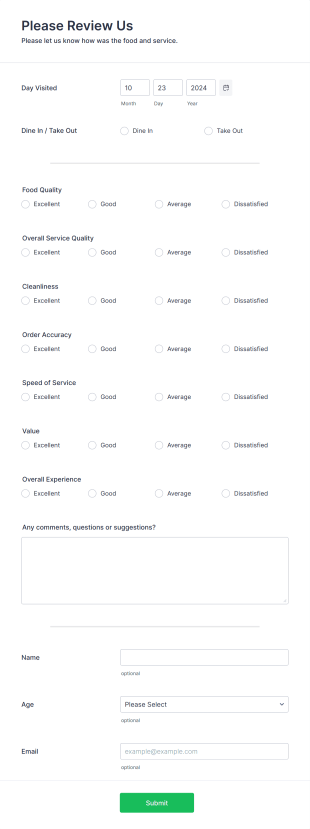
Restaurant Evaluation Form
Customers satisfaction is important for every business and to determine that you need to survey your customers. This restaurant survey form is designed for this purpose. This restaurant evaluation form let your customers rate or evaluate the quality of your services, this includes food quality, overall service quality, cleanliness, order accuracy, speed of service and others. To deliver the highest level of service, this restaurant review form will help you easily understand your customers and their tastes based on their feedback. So if you own a restaurant and you want the quickest and hassle-free to collect feedback, this restaurant review template free is all you need!

Online Slam Book Form
Want an online slam book format for friends? Create your own with Jotform!
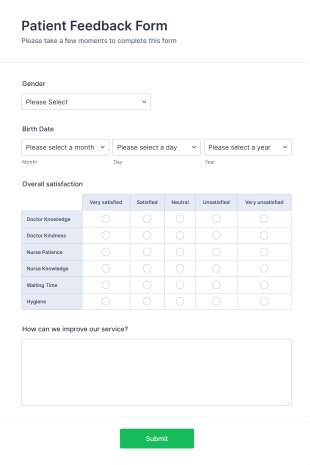
Patient Feedback Form
A patient feedback form is a survey with questions that allows medical doctors to gather feedback from patients regarding their overall experience with the clinic.

Student Survey
Find out what students think about topics like curriculum, materials, and facilities with Student Survey.

Exit Interview Form
HR departments can use this free Exit Interview Form to conduct exit interviews online. Customize the form and share via email to quickly collect employee feedback.

Product Survey Form
A product feedback form is a good way to gauge how well (or bad) you're doing as a company. With this product survey form sample, a variety of commonly asked questions are readily available for you to use. This product survey form will ask your respondents how long they have been using your products/services, their impression on how you compete with other competitors, their satisfaction about the products/services you offer and a couple more that's related to the overall experience they had.
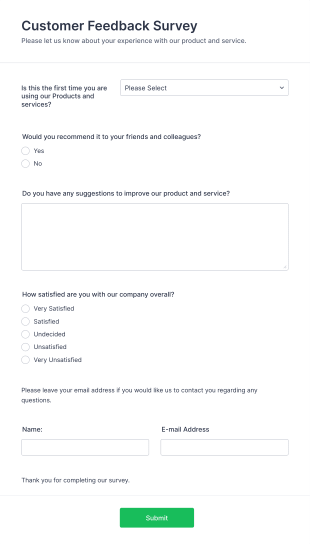
Customer Feedback Survey
Great tool to capture customers concerns on products and services used

Follow Up Survey
A follow up survey is a customer feedback survey that allows customers to review a company or individual. Easy to use. No coding.
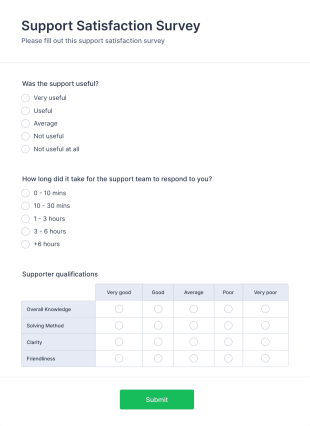
Support Satisfaction Survey
A support satisfaction survey is used by companies to collect feedback about their customer support services.
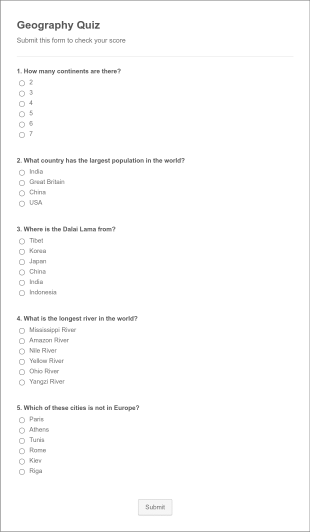
Quiz Form With A Calculated Number Of Correct Answers
Calculate a number of correct answers with a Form Calculation Widget, and show that number on the form's Thank You page.

Past Crushes Survey
An online past crushes survey is a questionnaire used by students to collect information about previous relationships.
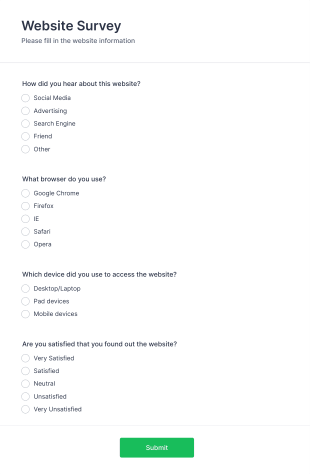
Website Survey
A website survey is used to collect information about websites, users, or the website itself.
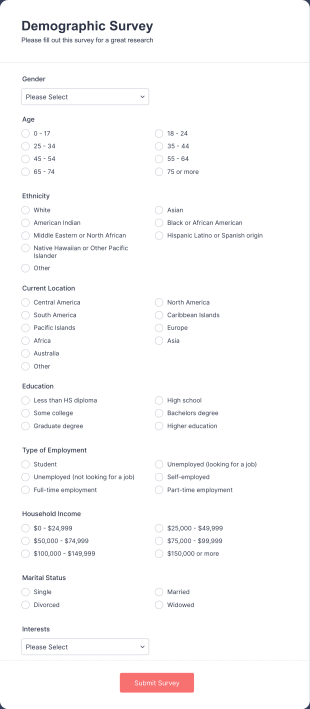
Demographic Survey
Here is a simple demographic survey template that you can use to determine your market or to make any other research. With this demographic form for research, you can gather gender, age, education, household income and interests of the form's respondents. Use this demographics form template to start your survey now! Or, simply make your own online surveys from scratch!
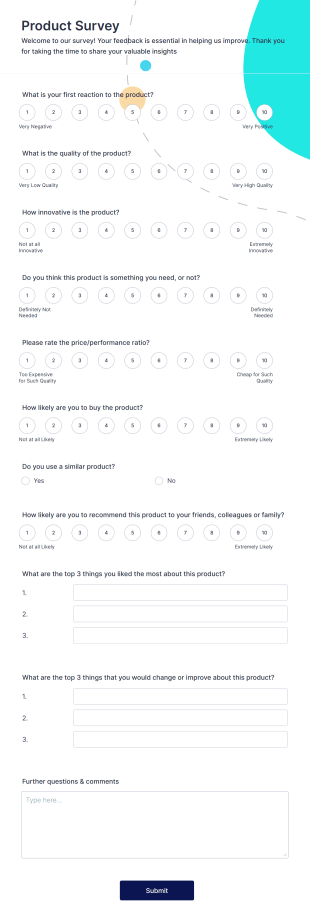
New Product Survey
A new product survey is a tool used by businesses to collect customer feedback about a new product.

COVID 19 Vaccine Survey
Get to know how people feel about the new COVID-19 vaccine with a custom online survey. Easy to personalize, embed, and share. Option for HIPAA friendly features.

Evaluation Survey Form
An evaluation survey form is a form template designed to collect information from students about their experience at the school, the quality of the education, and any suggestions for improvement.
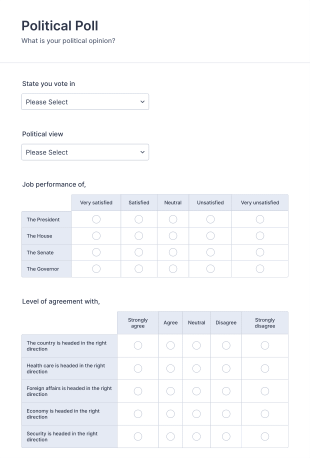
Political Poll
Get a full scale political poll from the visitors and determine what the country thinks of the current politics.

Instructor Evaluation Form
An Instructor Evaluation Survey is a feedback form used by teachers to evaluate the performance of an instructor.

My Favorite Things Questionnaire
A My Favorite Things Questionnaire is a form template designed to ask students about their favorite movie, favorite place to go, food, person, game, biggest fear, and greatest hope.
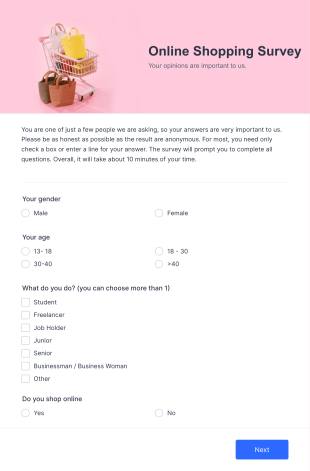
Online Shopping Survey
An online shopping survey is a questionnaire used by online stores to collect feedback from their customers. Whether you run a book, magazine, clothing, or furniture store, use this free Online Shopping Survey!
Product Surveys

Product Customer Feedback Form
A Product Customer Feedback Survey is a customer feedback survey that allows clients to review a company's products and services.
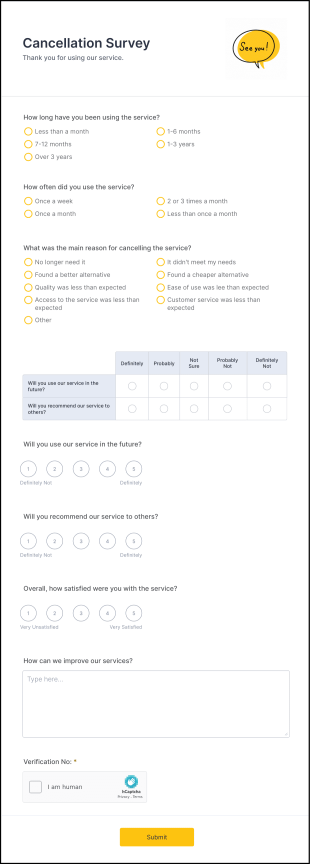
Cancellation Survey
A cancellation survey is a questionnaire used to determine the reasons why customers cancel their service. Fully customizable and free.

Voice Of The Customer Survey
Get important customer feedback online. Easy to customize and embed with no coding. Great for small businesses. Collect and view responses on any device.
Technology Surveys

Technology Survey For Remote Learning
Let students rate their remote learning experience with a free online Technology Survey for Remote Learning. Easy to customize and share. Fill out on any device.
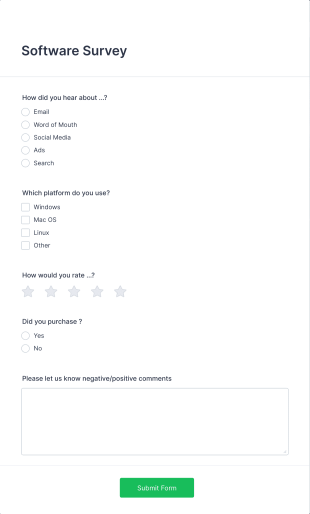
Software Survey Form
A software survey is a questionnaire used by a software company to collect feedback from its users. If you work in software, use our free Software Survey Form to talk to your customers and find out more about how they use your product!
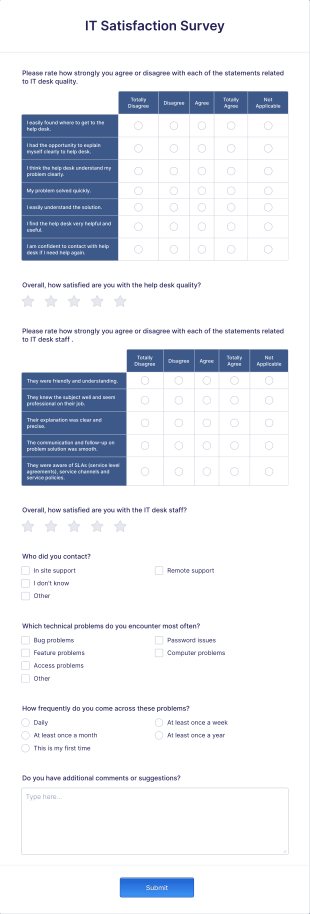
IT Satisfaction Survey
Let's measure how satisfied your customers are with the IT service you provide with the IT Satisfaction Survey. No code required!
Healthcare Surveys


Health Survey
A Health Survey is a form template designed to collect medical information from patients and log their anamnesis

Mental Health Survey
Conduct mental health assessments with this free survey template for businesses, schools, and more. Easy to customize and fill from any device. No coding.
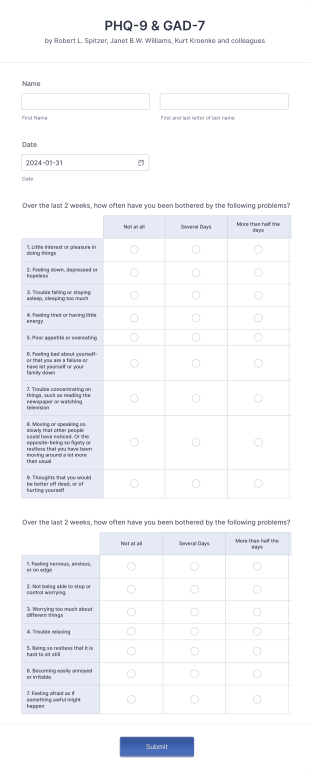
Patient Health Questionnaire And Generalized Anxiety Disorder Questionnaire
A free Patient Health Questionnaire and Generalized Anxiety Disorder questionnaire is an excellent tool for getting everything you need in one convenient place! Accessible through any mobilde device. Fully customizable.
Education Surveys

Classroom Observation Survey
Does your school accommodate external reviews by conducting class observations? Once the reviewer is done, observation survey forms would surely help in letting them share their feedback. This classroom observation template will ask the panel the teachers/classes they observed, the grade level, how the environment was throughout the session, and the overall knowledge, skills, behavior, class management, and the overall impression of the class. Use this observation survey template to improve your teachers and students alike.

Teacher Satisfaction Survey
Make the teachers happy by attending to their needs and listening to their feedback by using this Teacher Satisfaction Survey. This form template contains all the required questions when building a survey.

Student Interest Survey
Encourage the students to enjoy the school year by making them interested in the school activities and class lessons. In order to identify their expectations, have them fill up this Student Interest Survey form.
Business Surveys
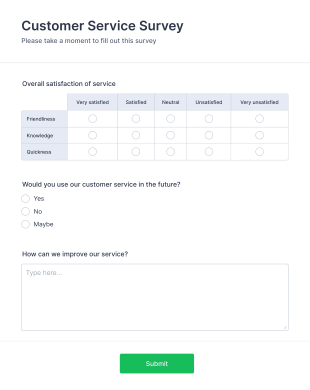
Customer Satisfaction Survey Form
Get to know your customers with a free online Client Satisfaction Survey. Easy to customize, share, and embed. Analyze results to improve your business.
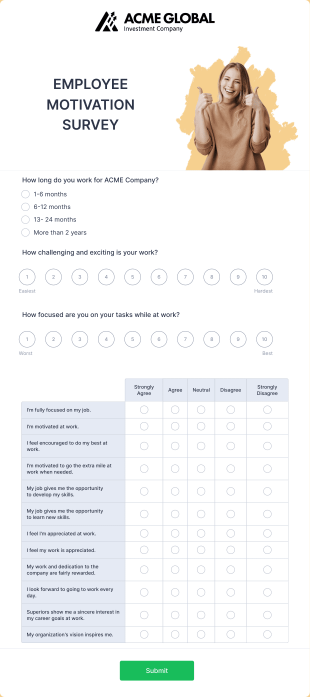
Employee Motivation Survey
Conduct motivation self-assessments on any device with an online Employee Motivation Survey. Free to customize and share. Analyze results to improve your business.

Business Demographic Survey
A business demographic survey is a survey that captures information about the demographics of a business and its customers. Fully customizable and free.
About Survey Templates
Surveys are the perfect way to gauge customer, employee, or even just public opinion about your brand. Get started the easy way: select a free online survey template from Jotform. We have all the survey and reporting tools to find and collect helpful data. It's perfect when you need to understand customer demographics, or when you need to conduct a market research survey. Select from one of our pre-made sample survey forms or make your own survey from scratch in just minutes. Once you have selected a survey template, use the Jotform builder to design, format and customize your survey form. Try one of our free online survey form templates today!
You can also check out our ready-to-use questionnaire templates prepared for a variety of use cases which allows you to customize your online questionnaire with our drag-and-drop Form Builder.
Frequently Asked Questions
1) what are survey templates.
Survey templates are ready-made sample surveys with built-in questions. Instead of creating a survey from scratch, you can use a template as a starting point, then customize it with your own specific questions, branding elements, and more.
2) Where can I find survey templates?
You can find many survey templates online for free! Jotform’s survey templates are all available in our form templates library. Not only are they free, but they’re totally customizable with our no-code, drag-and-drop form builder, so you don’t have to switch between platforms to find a survey template, customize it, and share it with your audience!
3) What types of survey templates are available?
Jotform offers a wide variety of survey templates for different industries and use cases, including surveys for HR, marketing, products, customer satisfaction, and more. Plus, we have a great selection of employee and education surveys, with everything from polls and assessment forms to motivation and feedback forms.
4) Are survey templates customizable?
Absolutely! As mentioned above, Jotform’s drag-and-drop form builder is the ultimate tool to customize your survey templates in a matter of minutes. You can adjust fonts and colors, drag and drop form fields, drop in logos and images, and so much more. Plus, feel free to sync with our 100-plus integrations — like Google Drive or Dropbox — to add extra functionality to your survey or include it in your existing workflows.
5) How can I use a survey template?
To use a survey template, just select the template you want to use and edit it according to your needs. With Jotform, simply navigate to our Survey Templates page and choose the right one for you. Click Use Template , then use our drag-and-drop Form Builder to customize it and share it with others, all from one place. Responses will automatically be sent to your Jotform Inbox, and you can analyze your data in Jotform Tables and Jotform Report Builder.
6) Can I create my own survey template?
Yes, you can build your own survey from scratch. Navigate to Jotform’s Form Builder, click Create Form , then Start from Scratch . From there, you can add questions and widgets to create the perfect survey template to use as needed.
7) Are survey templates free to use?
Depending on where you source them, some survey templates are free, and some you’ll need to pay for. Jotform’s 1,000-plus survey templates will always be 100 percent free. You’ll just need to upgrade to a paid plan to increase the limit on the number of submissions you receive.
8) How many questions are typically included in a survey template?
Make sure your respondents don’t get “survey fatigue” before they even start taking your survey! The tricky part about this question is that there’s no exact answer — it depends on a number of factors, like who your audience is, what information you need, and what your purpose is. In general, a survey should never take longer than 10 minutes, which means that 5–10 questions is usually a safe range.
9) How do I choose the right survey template for my needs?
Before you choose a survey template, you need to define your research objectives. This can be done by doing a deep dive into your product, service, or team and pinpointing specific topics you want to gather more data on. Once you’ve done this, you can search for survey templates related to your research objective and find one that most closely matches your needs.
10) Can survey templates be used for both online and offline surveys?
Sometimes, you need to be offline to conduct market research or surveys in the field — that’s why finding survey tools that work offline is a game-changer. Jotform Mobile Forms allows you to create, edit, and fill out forms from any location and on any device, and even collects data offline to be populated later once you connect back to the internet. Don’t let spotty cell reception stop you from collecting the survey data you need!
11) What are the benefits of using a survey template?
Using a survey template can cut down on the time you would otherwise spend building a survey from scratch, so that you can spend more time collecting responses and analyzing data to make better business decisions. On top of that, survey templates provide great inspiration for the kinds of questions you should be asking, as well as the format of those questions (multiple choice, yes/no, fill-in-the-blank, etc.).
12) Can survey templates be used for different industries and sectors?
Survey templates can be used across every industry and sector! Whether you’re collecting employee feedback, reaching out to customers about a potential new product, or simply just polling your friends for fun, there’s a survey template for you.
13) How do I modify a survey template to suit my specific requirements?
To modify a survey template to suit your specific needs, you can customize it with your own text, images, branding, and more. Jotform makes this easy with our drag-and-drop form builder. Simply replace our questions with your own, add new fields, switch up the survey colors and fonts, include your logo, and more. Then share it through email, a link, or a QR code, or embed it on your website.
Your account is currently limited to {formLimit} forms.
Go to My Forms and delete an existing form or upgrade your account to increase your form limit.
Free Shipping On ALL Orders | Guaranteed Lowest Prices | Defect Free Guarantee | Warranty on All Machines | Same Day Shipping
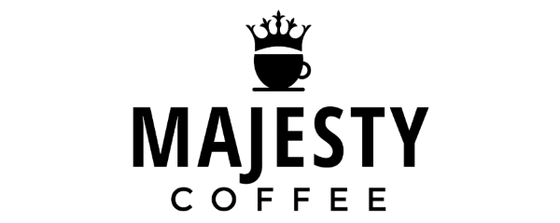
Sign in | Join
- Shipping & Return
- My Addresses
Recover password
Enter your email:
Remembered your password? Back to login
Create my account
Please fill in the information below:
Already have an account? Login here
Got a Question? Call Us
(888) 978-5224 Mon-Sun 9am-6pm Eastern
How to Run a Successful Coffee Shop: Expert Tips and Strategies

Running a successful coffee shop entails more than just brewing an excellent cup of java. Aspiring coffee shop owners must carefully consider multiple factors and put effort into every facet of the business, from the location to the menu offerings. After all, thriving in the competitive coffee market requires strategic planning, customer awareness, and innovative ideas.
Understanding the coffee industry is crucial, as success depends on the ability to anticipate trends and shifts in consumer habits. Additionally, coffee shop entrepreneurs must devise a solid business plan to mitigate risks and overcome challenges. Ultimately, cultivating a comfortable atmosphere, combined with quality service, sustainable practices, and continuous improvement, will pave the way for long-term profitability.
Key Takeaways
- A solid business plan and understanding of the coffee industry is essential to success.
- Emphasizing a comfortable atmosphere, effective marketing, and quality service are crucial elements.
- Sustainability and continuous improvement are integral to staying ahead in the competitive market.
Understanding the Coffee Industry
The coffee industry is a complex and dynamic sector, encompassing everything from production and distribution to consumption. It is essential for anyone looking to open a successful coffee shop to have a firm grasp of the industry's key concepts, trends, and challenges.
One critical aspect of the coffee industry is understanding the supply chain. Coffee is primarily grown in tropical regions, with Brazil, Vietnam, Colombia, and Indonesia among the top producers. These countries export green coffee beans, which are then roasted and processed into the final products enjoyed by consumers around the world. Establishing relationships with reliable suppliers, understanding seasonal variations, and ensuring the quality and ethical sourcing of beans are essential factors to consider when sourcing ingredients for your cafe.
Another crucial element is staying up-to-date with industry trends, which can range from new brewing methods and flavor profiles to innovative marketing strategies and sustainability initiatives. By closely monitoring these developments, café owners can position themselves at the forefront of their market niche, capitalizing on emerging customer demands and preferences.
Competition in the coffee shop market is fierce, with both independent cafes and franchised chains vying for market share. Identifying your target audience and creating a unique selling proposition (USP) is key to standing out from the crowd. This might include highlighting exceptional coffee quality, offering a specific ambiance, or specializing in certain brewing methods or products.
Lastly, understanding the regional dynamics of the coffee industry plays a vital role in running a successful coffee shop. Various factors, such as local regulations, supplier availability, and customer preferences, can influence the success and operation of a cafe. It's crucial to tailor your coffee shop's offerings, strategies, and promotional efforts to the specific demographics, tastes, and demands of your target market.
By thoroughly understanding the ins and outs of the coffee industry, future café owners can create a solid foundation from which to build a thriving, successful business in this increasingly competitive sector.
Creating a Business Plan
Market research.
Before starting a coffee shop, it is crucial to conduct thorough market research. This will help you understand the industry, identify your target market, and position your business effectively. Begin by researching the local coffee scene, including the coffee shops in your area, the demographics of their customers, and any potential competitors. This information will enable you to make informed decisions about your target audience, the type of coffee shop to open, and which products and services to offer.
SWOT Analysis
A SWOT analysis is a valuable tool for understanding your coffee shop's strengths, weaknesses, opportunities, and threats. This allows you to capitalize on advantages and minimize any potential disadvantages. Consider the following categories in your analysis:
- Strengths: What does your coffee shop offer that sets it apart from competitors? This could include unique products, an ideal location, or exceptional customer service.
- Weaknesses: Identify areas where your coffee shop may be lacking or could face challenges. Consider factors like a limited menu, lack of experience in the industry, or high startup costs.
- Opportunities: Look for areas of potential growth or ways to stand out in the market. This could include expanding your menu, adding a loyalty program, or hosting events and workshops.
- Threats: Be aware of external factors that could negatively impact your coffee shop, such as nearby competitors, economic downturns, or changing consumer preferences.
Financial Projections
Creating a realistic financial projection is essential for the success of your coffee shop. It will help you understand the costs of setting up and operating your business, as well as the revenue needed to achieve profitability. Your financial projection should include:
- Startup Costs : These are the expenses required to establish your coffee shop, such as purchasing equipment, renovating the space, and licensing fees.
- Operating Expenses : These are the ongoing costs associated with running your coffee shop, including payroll, rent, utilities, and inventory.
- Revenue Projections : Estimate how much revenue your coffee shop will generate from its products and services. Consider factors such as foot traffic, average ticket price, and peak hours.
- Break-Even Analysis : Determine when your coffee shop will begin to make a profit by calculating how long it will take to cover your startup costs and operating expenses.
By conducting market research, performing a SWOT analysis, and creating a comprehensive financial projection, you'll greatly increase the likelihood of successfully launching and operating your coffee shop.
Selecting the Right Location
One of the most important decisions in running a successful coffee shop is selecting the right location. This can significantly impact your sales, customer base, and overall operations. In this section, we will explore the key factors to consider when choosing a location for your coffee shop, including foot traffic, competitor analysis, and swift commutes.
Foot Traffic
It's essential to choose a location with high visibility and a high volume of foot traffic. Busy areas like office districts, universities, or shopping centers are ideal locations for attracting regular customers and maximizing your exposure. Ensuring easy access for pedestrians can significantly improve your coffee shop's success.
Competitor Analysis
Before finalizing your location, it's important to conduct competitor analysis by identifying other coffee shops operating in the area. Take note of their customer base, menu offerings, and ambiance, and find ways to stand out from the competition. While it's advantageous to be situated near other coffee shops, make sure there's enough market demand in the area to accommodate additional businesses.
Swift Commutes
Choosing a location that allows for swift and easy commutes is critical. Ensure your coffee shop is easily accessible via public transportation or has ample parking spaces nearby. Proximity to major roads and highways can also help in increasing your customer base by attracting commuters on their way to work or home.
Designing a Comfortable Atmosphere
Interior design.
When designing a coffee shop, it's important to choose an aesthetic that appeals to the targeted customers. This could range from an old-fashioned look to a modern or tongue-in-cheek retro vibe. The design concept should reflect the intended target audience and create a welcoming environment. Some elements to consider include wall color, which can set the mood and atmosphere. Whether opting for dark colors or light, calming hues, make sure the chosen palette complements the overall design theme.
Furniture Selection
Furniture plays a crucial role in creating a comfortable atmosphere in a coffee shop. Consider the following when selecting furniture:
- Comfort: Choose chairs and seating options that invite customers to stay and enjoy their beverages.
- Style: Ensure the furniture style aligns with the chosen design concept and aesthetic.
- Functionality: Prioritize practicality and accommodate various customer needs, such as options for individuals, groups, and people using laptops.
Proper lighting is essential for contributing to a comfortable and inviting atmosphere. Here are a few considerations for lighting in a coffee shop:
- Ambient lighting: Soft, warm lighting makes the space feel cozy, while cool, bright lighting creates a more energized atmosphere.
- Task lighting: Provide additional lighting in areas where customers may read or work, ensuring they have enough light to do so comfortably.
- Accent lighting: Utilize decorative lighting to highlight specific areas and elements within the coffee shop, such as artwork or unique architectural features.
Menu Planning and Pricing
Coffee selection.
One of the first considerations when planning your coffee shop menu is coffee selection . Your customers will expect a choice of a few drinks, with options that cater to different preferences and varying levels of coffee knowledge. Offer a basic menu with standard options such as espresso, cappuccino, and Americano. Add some specialty drinks to showcase unique flavors and techniques, such as Spanish latte or Chemex-brewed coffee.
Alternative Options
In addition to traditional coffee, it's essential to provide alternative options for customers who may have dietary restrictions or simply desire something different. Include:
- Milk substitutes : Have a variety of choices like soy, almond, oat, and coconut milk.
- Non-coffee drinks : Offer herbal and black teas, hot chocolate, fruit smoothies, and other non-coffee options.
- Bakery items and light snacks : Partnering with local bakeries or providing in-house-made snacks, such as pastries, sandwiches, and salads, can complement your drink menu and encourage customers to stay longer.
Price Setting
Lastly, when considering pricing for your coffee shop menu, it's important to strike a balance between profitability and customer satisfaction. Keep in mind that coffee has a high markup potential (generally around 80% or higher) due to its relatively low upfront cost and customer willingness to pay for convenience.
Tactfully determine your prices by:
- Evaluating costs : Factor in ingredient costs, labor, rent, and overhead expenses to ensure you are making a profit.
- Competitor analysis : Research prices at nearby coffee shops to remain competitive in the market.
- Consider your target audience : Pricing should align with the clientele you wish to attract, whether it's college students, business professionals, or other demographics.
- Avoid underpricing : While competitive prices are important, undercharging for high quality and excellent customer service can leave a negative impression.
When incorporating all of these elements into your menu, aim for a layout that is visually appealing, clear, and easy to navigate. Proper formatting will ultimately lead to a better customer experience and support the success of your coffee shop.
Effective Marketing Strategies
Running a successful coffee shop requires strategic planning and effective marketing techniques. This can help attract customers and create a loyal customer base. Here are three main marketing strategies for a coffee shop to consider:
Social Media Marketing
Using social media platforms is an essential way to engage with customers, showcase menu items, and promote any specials or events. Create accounts on popular platforms such as Facebook, Instagram, and Twitter, and maintain an active presence with regular posts and updates. Engage with customers by responding to comments and messages, and encourage user-generated content by reposting customers' photos and tagging your coffee shop. Additionally, use location-based targeting to attract local customers and utilize relevant hashtags for increased visibility.
Offline Promotions
Don't disregard the power of offline promotions as they can significantly contribute to generating buzz about your coffee shop. Implementing traditional marketing methods like distributing flyers, offering discounts, and hosting community events can help increase foot traffic and create a local connection. Collaborate with other local business owners for joint promotions and consider sponsoring community events to build brand awareness. Lastly, maintain an aesthetically pleasing and comfortable environment for customers, as word-of-mouth marketing is invaluable for any coffee shop.
Loyalty Programs
Loyalty programs are an excellent way to reward regular customers and encourage new ones to become repeat visitors. Offer a rewards system, such as a punch card or a digital app, where customers can accumulate points or stamps for each purchase, redeemable for free or discounted items. Customize the loyalty program based on customer preferences, like offering discounts on popular menu items or free refills. Additionally, celebrate special occasions like customers' birthdays, offering them personalized discounts or freebies to further strengthen customer loyalty.
Maintaining Quality Service
Staff training.
A crucial aspect of running a successful coffee shop is ensuring that your staff is well-trained. Employees should have a strong understanding of the coffee-making process, and be familiar with the different types of equipment necessary for making high-quality beverages. Investing in commercial espresso machines and providing hands-on training will help ensure that your staff can consistently provide customers with exceptional drinks. Additionally, educating your team on customer service techniques and proper store policies will enable them to handle any situation that may arise, and contribute to a positive and welcoming environment.
Customer Feedback
Being open to customer feedback is essential for maintaining quality service. Collecting input from your clientele allows you to understand their needs and preferences, and make improvements where necessary. Always encourage your customers to offer their thoughts on your coffee, service, and overall experience through comment cards, online reviews, or simply by asking for their opinions directly. By actively listening and responding to customer feedback, your coffee shop will continually improve and maintain a high level of quality service.
Consistency
Finally, maintaining consistency in your coffee shop's products and services is key to ensuring success. Regularly assessing your coffee beans, brewing processes, and presentation will help you identify any areas where consistency may be lacking. This can mean conducting daily taste tests and regular equipment maintenance checks, or creating and adhering to standardized procedures for employees. Maintaining consistency not only contributes to the quality of your coffee shop's offerings but also builds trust and loyalty among your customers.
Sustainability Practices
Sustainability is a crucial factor in running a successful coffee shop. Integrating environmentally-friendly and ethically-sourced practices can not only reduce the business's impact on the environment, but also appeal to the growing consumer demand for sustainable options.
To start, sourcing coffee beans from certified sustainable suppliers is essential. Look for certifications such as organic, Fairtrade, UTZ, or Rainforest Alliance. These certifications ensure a high standard of environmental and social practices and can help set the foundation for running a sustainable coffee shop.
Another key aspect is to replace single-use plastics with more eco-friendly alternatives. In lieu of plastic cups and plates, opt for wooden stirrers, paper straws, compostable cups, lids, and plates. This helps reduce waste and demonstrates a strong commitment to sustainability.
Forming partnerships with suppliers and service providers who prioritize environmental health can also contribute to the coffee shop's overall sustainability. By choosing partners with similar eco-friendly values, the coffee shop sends a signal that it supports responsible practices.
Furthermore, implementing composting services, either through the local city or by composting the shop's waste in-house, can help manage food waste in an environmentally friendly manner. This practice has become an important aspect of running a sustainable business.
In conclusion, coffee shop owners who adopt these sustainability practices can protect the environment while establishing a strong brand reputation that resonates with eco-conscious customers. By focusing on sustainable sourcing, reducing waste, and partnering with environmentally-minded suppliers, these business owners can set a strong example for others to follow.
Continuous Improvement
In order to run a successful coffee shop, it is crucial to focus on continuous improvement. This process involves regularly analyzing and adjusting various aspects of your business to ensure you remain competitive and meet customer demands. By consistently seeking opportunities for improvement, you can maintain a high level of service, increase sales, and build customer loyalty.
One key area to focus on is employee training . As the face of your business, well-trained and knowledgeable staff can greatly impact the customer experience. Invest in training programs and workshops to teach your employees about the unique products you offer, as well as proper brewing techniques and customer service. Regularly updating and refining employee skills will not only enhance their performance but also increase their job satisfaction.
Another aspect to consider is innovation in products and services . Stay up-to-date with the latest industry trends and incorporate popular offerings to attract new customers. For example, if plant-based milk options are gaining popularity, consider adding them to your menu. Offer seasonal drinks and limited-time promotions to keep your customers excited and encourage repeat visits.
Don't forget about the importance of analyzing customer feedback . Actively solicit feedback from your patrons and use it to identify areas for improvement. You can gather valuable data by conducting surveys, monitoring online reviews, and engaging in social media. Listening and responding to customer concerns and suggestions will demonstrate that you care about their opinions and are committed to making positive changes.
Adopting efficient operations and cost management strategies will also contribute to continuous improvement. Routinely analyze your expenses, such as rent, inventory, and labor costs, to identify inefficiencies. Streamline processes and consider implementing automation tools where appropriate to minimize waste and maximize productivity.
Lastly, monitoring and benchmarking your coffee shop's performance against competitors can help you identify strengths and weaknesses. Keep an eye on successful coffee shops in your area, as well as industry leaders, to learn from their best practices. By continuously refining your strategies and implementing meaningful changes, you will ensure the long-term success of your coffee shop.
Frequently Asked Questions
What is the key to effective coffee shop management.
Effective coffee shop management involves a combination of understanding customer needs, maintaining a clean and welcoming environment, and creating an efficient workflow. It's crucial to train and motivate employees, monitor expenses and revenues, and make data-driven decisions based on performance metrics. Developing strong relationships with suppliers and local business partners is another essential element of successful management.
What operational strategies lead to a successful cafe?
Operational strategies that lead to a successful cafe include optimizing store layout, implementing inventory management systems, and adopting sustainable practices. Offering great customer service, cultivating a culture of employee satisfaction, and using data to continuously assess operations will enhance overall performance. Efficient processes, from staff training to menu management, ensure a well-run cafe.
What are the essential equipment needs for starting a coffee shop?
The essential equipment needs for starting a coffee shop include high-quality espresso machines and grinders, refrigeration and storage units, sinks, water purification systems, and a point-of-sale (POS) system. Other necessary items are ovens and display cases for baked goods, seating and tables, and dishwashing equipment. Investing in reliable equipment and maintaining it is crucial for smooth operations.
What licenses and permits are necessary for opening a coffee shop?
Licenses and permits vary by location, but generally, a coffee shop will need a business license, health department permit, food service license, zoning permit, and fire department permit. It may also be necessary to obtain specific permits for outdoor seating and signage. Be sure to research local regulations and comply with all requirements to avoid any potential issues or fines.
What strategies attract customers to a cafe?
Strategies to attract customers to a cafe include offering high-quality products and services, creating a unique and inviting atmosphere, and engaging with the local community. Utilizing effective marketing tools such as social media, loyalty programs, and local partnerships can help broaden your cafe's reach. Keep your menu fresh and innovative, and consider seasonal promotions or limited-time offerings to entice new customers.
How can a coffee shop maximize its profitability?
Maximizing profitability in a coffee shop involves controlling costs, optimizing pricing, monitoring sales, and analyzing key performance indicators (KPIs). Streamlining operations, reducing waste, and offering a carefully curated menu that balances customer favorites with specialty drinks can enhance profit margins. Stay informed about industry trends and competitor offerings to ensure you maintain a competitive edge.

Tony Barlow
Tony Barlow, with over a decade of experience in the coffee industry, is the go-to technical sales expert at Majesty Coffee. He's passionate about helping businesses find the right espresso equipment for their needs.
Featured products

MajestyCoffee Verified Customer Testomonials
This grinder does a great job for my decaf espresso beans! Thanks Baratza!
I went from a Breville Barista Express to this dual boiler beauty and couldn't be happier with this purchase. Cost a pretty penny, but every espresso made makes me reassured about my purchase. Shipping took a few days longer than normal, but assumed that was due to the open box. Steams milk incredibly quick, and my lattes taste even better! Hope this is my last espresso machine purchase since I don't think my wallet can take another hit like this.
The grinder has all the desirable features for all types of coffee beverages. The price is good and worth paying for this high quality product
Lelit Fred Conical Burr Coffee Grinder PL044MMT
I've had my Quick Mill Silvano machine for 3 years now. I purchased it after 2 Breville consumer machines crapped out after 2 years... one stopped making steam, the other leaked. And neither made great tasting coffee or substantial crema. So I took the plunge and purchased this machine and I'm so happy I did. What I love about it: the PID display of boiler temp and brew time. The simplicity of the controls. The fact that I can froth at the same time as pulling shots. The quality of the parts and longevity of the machine. The ease of cleaning. Finally, and most importantly, the great taste of the espresso I get every morning from the Silvano.
I just got my Lelit Bianca V3 and I love it. The people at Majesty Coffee were a delight to work with and they were very prompt. I would highly recommend them.
This machine has been a joy to own and use. Majesty Coffee was great to work with and I would definitely continue to buy from them.
Yes, $3,000 is a lot of money. However, when you decide to enter this high level espresso machine category (DB, PID, flow control, excellent steam power, etc.), you will quickly find that the Lelit Bianca V3 is a bargain. Moving up from a Gaggia Classic, I was concerned that I was over-buying and paying for a lot of features I would never use. Wrong! Initially, I left everything at factory settings and did not touch the flow control. A few weeks and tons of perfect shots later, I'm experimenting with shot profiles, Turbo shots... you name it. I'm getting great shots and only wish I had saved the money from the earlier machines and gone straight to the Bianca. It's that good. Downsides: None that I can see. You will love this machine.
Ceado E37J Espresso Grinder CEADO-E37J
A bit complicated but otherwise Very good machine. Tony was very helpful wirh instructions and helping me get started
I have been loving my new espresso machine! It is taking some time to dial in, but it has been a fun process.
My experience with Majesty Coffee was highly personalized. I had 8-9 emails with them about different color combinations, changing my mind as we went. They were service oriented every step of the way. They were out of the Elizabeth, so they offered a Bianca v3 which has ended years of frustration trying to get excellent shots and silky milk. It is spoiling me to a degree that I won’t be able to get coffee from a cafe without thinking that I could do so much better at home.
If you want the most you can get from the bean in front of you... this is the grinder to get. Fast to setup and dial in. Extracts the full flavor of the bean every time. I like the ability to take it apart in seconds for cleaning and reassembly is as fast. Grounds are not splattered all over your workplace. After 2 weeks I hit the grinder with a sponge and done in seconds too. Replacement parts are on the website. I would be shocked if I ever needed them. Great grinder for a great price. But this should be the last filter grinder you need.
Still waiting for the install company to contact us back for scheduling installation.
- Opens in a new window.
- Travel, Tourism & Hospitality ›
- Food & Drink Services
Coffee shops and cafes in the U.S. - statistics & facts
What is the biggest u.s. coffee shop chain, how much do u.s. consumers spend on coffee, key insights.
Detailed statistics
Market value of the coffee shop industry in the U.S. 2018-2022
Coffee shop count in the U.S. 2018-2022
Coffee & snack shop industry employee count in the U.S. 2012-2022
Editor’s Picks Current statistics on this topic
Cafes and Coffee Shops
Leading coffee shop chain sales in the U.S. 2022
Further recommended statistics
Industry overview.
- Premium Statistic Market value of the coffee shop industry in the U.S. 2018-2022
- Premium Statistic Coffee shop count in the U.S. 2018-2022
- Premium Statistic Coffee and snack shop industry market size in the U.S. 2011-2022
- Premium Statistic Coffee & snack shop business count in the U.S. 2012-2022
- Premium Statistic Coffee & snack shop industry employee count in the U.S. 2012-2022
- Basic Statistic Wages of U.S. fast food and counter workers 2022-2023, by percentile distribution
Market value coffee shop market in the United States from 2018 to 2022 (in billion U.S. dollars)
Number of coffee shops in the United States from 2018 to 2022
Coffee and snack shop industry market size in the U.S. 2011-2022
Market size of the coffee and snack shop sector in the United States from 2011 to 2022 (in billion U.S. dollars)
Coffee & snack shop business count in the U.S. 2012-2022
Number of businesses in the coffee and snack shop sector in the United States from 2012 to 2022 (in 1,000s)
Coffee & snack shop industry employee count in the U.S. 2012-2022
Number of employees in the coffee and snack shop sector in the United States from 2012 to 2022 (in 1,000s)
Wages of U.S. fast food and counter workers 2022-2023, by percentile distribution
Hourly wage estimates of fast food and counter workers in the U.S. from 2022 to 2023, by percentile distribution (in U.S. dollars)
Key players
- Premium Statistic Most valuable QSR brands worldwide 2023
- Premium Statistic Leading coffee shop chain sales in the U.S. 2022
- Premium Statistic Number of units of leading coffee shop chains in the U.S. 2022
- Premium Statistic Bakery cafe chains with the highest systemwide sales in the U.S. 2022
- Premium Statistic Selected top bakery cafe chains ranked by units in the U.S. 2022
Most valuable QSR brands worldwide 2023
Brand value of the 10 most valuable quick service restaurant brands worldwide in 2023 (in million U.S. dollars)
Sales of selected leading coffee shop chains in the United States in 2022 (in million U.S. dollars)
Number of units of leading coffee shop chains in the U.S. 2022
Number of units of selected leading coffee shop chains in the United States in 2022
Bakery cafe chains with the highest systemwide sales in the U.S. 2022
Leading bakery cafe chains in the United States in 2022, by systemwide sales (in million U.S. dollars)
Selected top bakery cafe chains ranked by units in the U.S. 2022
Number of units of selected leading bakery cafe chains in the United States in 2022
- Premium Statistic Order frequency from coffee & snack shops in the U.S. 2023
- Premium Statistic Frequency that consumers purchase coffee from a coffee shop in the U.S. 2023
- Premium Statistic Average amount spent on coffee per month by U.S. consumers in 2022
- Premium Statistic Number of cups of coffee consumers drink per day in the U.S. 2023
- Premium Statistic Frequency consumers drink coffee in the U.S. 2024
Order frequency from coffee & snack shops in the U.S. 2023
Frequency of ordering from coffee & snack shops in the United States as of the first quarter of 2023
Frequency that consumers purchase coffee from a coffee shop in the U.S. 2023
How often do you purchase coffee from a coffee shop?
Average amount spent on coffee per month by U.S. consumers in 2022
How much do you spend on coffee a month?
Number of cups of coffee consumers drink per day in the U.S. 2023
How many cups of coffee do you drink a day?
Frequency consumers drink coffee in the U.S. 2024
How frequently do you drink coffee?
- Premium Statistic Global brand value of Starbucks 2010-2022
- Premium Statistic Revenue distribution of Starbucks 2009-2023, by product type
- Premium Statistic Number of Starbucks stores in the U.S. 2005-2023, by type
- Basic Statistic American Customer Satisfaction Index: Starbucks in the U.S. 2006-2023
- Premium Statistic Starbucks brand profile in the United States 2023
Global brand value of Starbucks 2010-2022
Brand value of Starbucks worldwide from 2010 to 2022 (in billion U.S. dollars)
Revenue distribution of Starbucks 2009-2023, by product type
Revenue distribution of Starbucks from 2009 to 2023, by product type (in billion U.S. dollars)
Number of Starbucks stores in the U.S. 2005-2023, by type
Number of Starbucks stores in the United States from 2005 to 2023, by type
American Customer Satisfaction Index: Starbucks in the U.S. 2006-2023
American Customer Satisfaction index scores of Starbucks in the United States from 2006 to 2023
Starbucks brand profile in the United States 2023
Starbucks brand awareness, usage, popularity, loyalty, and buzz among restaurant chain customers in the United States in 2023
Further reports
Get the best reports to understand your industry.
- Quick service restaurants in the U.S.
- Restaurant industry in the U.S.
- Coffee market in the U.S.
- Coffee shops and cafes in the U.S.
Mon - Fri, 9am - 6pm (EST)
Mon - Fri, 9am - 5pm (SGT)
Mon - Fri, 10:00am - 6:00pm (JST)
Mon - Fri, 9:30am - 5pm (GMT)

Every Coffee Business Owner Needs To Ask Their Customers These Five Questions
by Garrett Oden | Sep 24, 2020 | 👋 Coffee Branding

One of the coolest parts about working with big technology clients is that sometimes they give me access to fancy reports to use as research. I’m talking the $2,000+ kinds of reports that normies like you and me see the price and think, “Wait, huh?!”
In early 2020, one of these reports revealed something that changed the way I think about branding, marketing… everything related to business.
By the end of 2020, customer experience will be the #1 brand differentiator, overtaking price and product.
(Here’s a link to a shorter free version of that report – it’s pretty interesting.)
That means, the way your customers interact with and feel about your brand is more important than the quality of your product, the price of your product, and a bunch of other factors.
So What’s It Got To Do With Coffee Businesses?
In coffee, most of us sell the same products around the same price. Chances are your competitors get their beans from the same few importers. We’ve talked about this a lot .
Rather than centering your marketing on your product, coffee businesses who market on the experience stand to win.
The key is knowing which parts of the experience your customers love, and which parts need to go back to the drawing board.
There’s no better way to discover what your customers love (or don’t love) about your experience than to… wait for it… ask them.
The trick is knowing which questions to ask to access those deeper emotional triggers. Surface-level questions get surface-level answers. Digging deeper is where the gold is.
Here’s how I like to get to that gold.
The 5 Customer Research Questions You Should Try ASAP
Don’t make this complicated. Just ask a smattering of customers if they can spare 4-5 minutes to answer a few questions. If you’re in a coffee shop setting, straight up ask someone who you have a good relationship with. If you’re selling online, send a personal email.
Ideally, you want to quickly interview 10-20 customers at a variety of loyalty levels. Your superfans will respond differently to casual, infrequent purchasers, and knowing the difference between a casual and superfan means you can actively try to make more casual fans into superfans.
Start with a personal catch-up question or two to make them feel at ease, then give these questions a spin.
Was there anything about your company that really stuck out to you when you first learned about us?
This question can help you understand the first impression you give. Do people instantly feel welcome when they walk through your door? Does your Instagram give off a vibe that’s not true to your brand?
People remember three parts of any experience: the beginning, a “ peak moment “, and the ending. You really want to nail that first impression, and this will give you a sense for how well you’re doing.
What made you want to come back a second time?
The second transaction signals success, not the first. Anyone can acquire a customer, but you have to earn their repeat business .
This question helps you identify what things about your business matter so much that they’ll keep coming back.
Is there anything that made you hesitate to come, anything that rubbed you the wrong way?
No experience is flawless, and even your best customers have things that bug them. The more of these questions, hesitations, and barriers you can identify and resolve, the easier it will be earn repeat business.
What does buying from us actually do for you personally that doesn’t happen other places?
The obvious answer is, “I get a nice caffeine boost with something that tastes delicious.” When they say that, shut your mouth. Give them a moment to process the question and look a little deeper.
Read: The Smile Test: Break Out Of Un-Memorable Customer Experiences
There are more specific benefits that your experience provides over other shops / ecommerce stores. Perhaps you’re faster than other shops, and customers know they can rely on you to be quick when they’re busy. Maybe your online coffee selection page makes it really easy to find a coffee they’ll love.
Be patient – they’ll give more details if you give them the space to.
If your company closed tomorrow, what would you miss the most?
Here’s the rub. What do you really mean to your customers? What will they be distraught about if you were to suddenly disappear? And what doesn’t really make that big of a difference?
Bonus: Where would you go for coffee instead if we closed?
What competitors do your customers perceive to be most closely aligned with their values? It’s good to keep an eye on your competition…
I’d love to hear how your research process goes. Do these questions work for you, or do you have any to add? Reach out and let me know!
Get smarter at coffee marketing.
Branding and marketing insights for cafes, roasters, and online stores. Get the actionable strategies you need to thrive, every week.
Start Getting Strategies

Hey 👋 I'm Garrett Oden
Freelance Coffee Marketer
I'm a coffee industry native who works with coffee brands around the world to create and execute captivating marketing strategies.
Recent Articles

Wrap Up: Your Favorite Coffee Marketing Strategies Of 2021
👋 Coffee Branding , 🚀 Coffee Ecommerce , 🤝 Coffee Shop Marketing
We explored 18 marketing strategies in 2021 for coffee shops, roasters, and online stores. Here were your top picks.

Don’t Sell Coffee Subscriptions, Sell Memberships
🚀 Coffee Ecommerce
Recurring revenue from subscriptions can make or break a coffee business. But subscriptions aren’t very sticky. Membership are.

Micro-Interview with Jeremy Teff: Designer Behind Onyx Coffee Lab’s Award-Winning Coffee Packaging
👋 Coffee Branding
I interviewed Jeremy Teff about his process for designing captivating coffee packaging and branding, and how to stand out in a competitive market.
Pin It on Pinterest
68 market research questions to ask (and how to ask them)
Example market research questions, market research questions to ask customers, market research questions for product development, market research questions for brand tracking, pricing survey questions for market research, how to write your own market research questions.
No two market research projects are alike, but happily there are some tried-and-tested questions you can use for inspiration to get the consumer insights you’re looking for.
It’s all about asking questions that are most relevant to the goals of your research. Every so often the best questions are actually quite straightforward, like asking consumers where they do their grocery shopping.
If you’re creating a customer profile, you’ll ask different questions than when you’re running creative testing with your target audience, or getting insights on key consumer trends in your market.
The right market research questions are the ones that will lead you to actionable insights, and give you a competitive advantage in your target market.
Let’s kick this off and get straight into some questions, shall we?

Where do we even begin with this?! There are so many types of research and we’ll get into which questions work for each below, but here are some classic example market research questions to get you started.
These particular questions are good for surveys that you might run when you’re running some essential consumer profiling research.
- Which of these products have you purchased in the last 3 months?
- Which of the following types of >INSERT YOUR PRODUCT/SERVICE CATEGORY< do you buy at least once a month?
- Approximately, how much would you say you spend on >INSERT YOUR PRODUCT/SERVICE CATEGORY< per month?
- What is stopping you from buying more of >INSERT YOUR PRODUCT/SERVICE CATEGORY<?
- When was the last time you tried a new >INSERT YOUR PRODUCT/SERVICE CATEGORY<?
- Please rank the following on how important or unimportant they are when deciding which >INSERT PRODUCT CATEGORY< to buy?
- Which of these brands are you aware of?
- Which of these brands have you purchased from in the last 3 months?
- How do you prefer to shop for >INSERT YOUR PRODUCT/SERVICE CATEGORY<?
- Why do you prefer to shop online?
- Why do you prefer to shop in-store?
- Thinking about the following, how often do you use/listen/watch each of these media?
- Where do you go to keep up to date with the news?
- Which social media platforms do you use daily?
- What mobile phone do you currently own?
Surely you want to talk to your current customers to understand why they buy from you and what they think about your products?
Correct! But your consumer research should definitely not end with current customers!

Here’s why you should think about broadening your research to include other groups and different market research methods :
- Current customers: This is a must! Running research to your current customers will help you understand how you can make your product or service better. These are the people who’ve spent their hard-earned cash on your products so they have a unique perspective on what kind of value you offer. In addition, understanding why your existing customer base chose your brand over others can help you create messaging that resonates with people who are still on the fence.
- Previous customers: People who used to buy your products but don’t anymore can give you valuable insight into areas you might need to improve. Perhaps your brand perception has shifted making some customers buy elsewhere, or maybe your competitors offer customers better value for money than you currently do. These are the kinds of areas you can learn about by running research to previous customers.
- Non-customers: You should also ask people who haven’t bought your products why they haven’t. That way you’ll learn what you need to improve to bring new customers in. You should ideally ask the same kinds of questions, so that you can learn about what product features you need to work on but also things like the messaging you should be putting out there to win people over.
Here are some questions that are perfect for competitive market analysis research. Some of these questions might sound similar to some from our previous section on consumer profiling—that’s because there’s often some crossover between these types of research. Consumer profiling often refers to a more general type of research that covers similar ground to market analysis. If you’re wondering how to calculate market size , questions like these would be a great starting point.
- How often do you usually purchase >INSERT YOUR PRODUCT/SERVICE CATEGORY<?
- Why do you buy >INSERT YOUR PRODUCT/SERVICE CATEGORY<?
- What types of >INSERT YOUR PRODUCT/SERVICE CATEGORY< do you buy?
- How often do you buy the following types of >INSERT YOUR PRODUCT/SERVICE CATEGORY<?
- Where do you buy your >INSERT YOUR PRODUCT/SERVICE CATEGORY<?
- Where do you find out about >INSERT YOUR PRODUCT/SERVICE CATEGORY<?
- Which of these brands have your purchased in the last 12 months?
- How would you feel if you could no longer buy >INSERT YOUR PRODUCT/SERVICE CATEGORY<?
- How important or unimportant do you find the following topics? (e.g. sustainability, diversity and inclusion, ethical supply chain)
- What could be improved about the products you currently use?

By involving consumers in the product development process, you can make sure that your products are designed to meet—and ideally exceed—their needs.
Product market research can be done at several points in the product development process, by asking potential customers in your target market questions about existing products (yours or competitors’), prototypes, or just your own early-stage product ideas.
You can dive into the customer experience, specific product features or simply find out if the product quality matches the value proposition you’re putting out there.
Sometimes you even get a surprising answer to the question: how does our product or service help people?
You might learn from the survey responses that customers are using your product in a different way than you intended, opening you up to new target markets and different product types in the future.
Asking these questions also allows you to get feedback on your designs, so that you can make necessary changes before the product is released. Here’s some inspiration for when you’re conducting product market research.
There are different types of new product development research. A key type is Jobs to be done research. This research digs into the practical reasons people buy products—the jobs they need to get done with a specific product. You use these insights to help you create products that will genuinely help consumers, and that they’ll ultimately want to buy.
- How many times have you carried out [INSERT ACTIVITY] in the last 12 months?
- How much time would you typically spend on this [INSERT ACTIVITY]?
- How important or unimportant is carrying out this [INSERT ACTIVITY]?
- How satisfied or unsatisfied do you feel when carrying out this [INSERT ACTIVITY]?
- What is the best thing about carrying out [INSERT ACTIVITY]?
- How does carrying out [INSERT ACTIVITY] make you feel? Please select all that apply
- What particular problems or challenges do you run into while carrying out [INSERT ACTIVITY]?
When you’re cooking up your brand’s next product, you’ll want to go through a concept testing phase. This is where you ask consumers what they think about your idea and find out whether it’s likely to be a success. Here are some of the questions you could ask in your concept testing research.
- To what extent do you like or dislike this idea/product? [ATTACH IMAGE]
- What do you like about this idea/product?
- What do you dislike about this idea/product?
- Is easy to use
- Sounds tasty
- Is good quality
- Is Innovative
- Is different from others
- Purchase this product
- Replace the product I currently own with this
- What other products this idea/product reminds you of? Please provide as much detail as possible including the product name.
- What feature(s), if any, do you feel are missing from this product?
- How would you improve this idea/product? Be as descriptive as possible!
- What issues do you solve through the use of this product?
- When can you see yourself using this product? Please select all that apply.
- The price for this product is $25.00 per item. How likely or unlikely would you be to buy this product at this price?
Get inspired with NPD survey templates
Our in-house research experts have created New Product Development (NPD) survey templates to give you the perfect starting point for your product research!
Does the perspective of new customers change over time? How do you compare to other brands, and how do you become the preferred brand in your market and increase that market share?
Brand perception and brand awareness are super important metrics to track. These insights can be used to improve customer experience and satisfaction on a higher level than just product: the relationship you have with your customers.
This research can also help you understand how to reach the holy grail of branding: turning loyal customers into brand ambassadors.
You should also remember to ask marketing research questions about your brand to existing and potential customers.
Existing customers might have a different view after having interacted with your team and products, and you can use that to manage the expectations of your target customers down the line. And potential customers can help you understand what’s holding them back from joining your customer base.
Top tip: it’s completely fine (and super beneficial!) to run brand tracking into your competitors’ brands as well as your own. Replicating research for different brands will give you a tailored benchmark for your category and position.
Here are some key questions to ask in your brand tracking research.
- Which of the following, if any, have you purchased in the past 12 months?
- Thinking about >INSERT YOUR CATEGORY<, what brands, if any, are you aware of? Please type in all that you can think of.
- Which of these brands of facial wipes, if any, are you aware of?
- Which of these facial wipe brands, if any, have you ever purchased?
- Which of these facial wipe brands, if any, would you consider purchasing in the next 6 months?
- e.g. Innovative
- Easy to use
- Traditional
- We’d now like to ask you some specific questions about >INSERT YOUR BRAND<.
- When did you last use >INSERT YOUR BRAND<?
- What do you like most about >INSERT YOUR BRAND<?
- What do you like least about >INSERT YOUR BRAND<?
- How likely would you be to recommend >INSERT YOUR BRAND< to a friend, family or colleague?
- Why did you give that score? Include as much detail as possible
- In newspapers/magazines
- On Instagram
- On Facebook
- On the radio
- Through friends/family/colleagues
- When did you last use >INSERT MAIN COMPETITOR BRAND<?
- How likely would you be to recommend >INSERT MAIN COMPETITOR BRAND< to a friend, family or colleague?
Kick off your brand tracking with templates
Track your brand to spot—and act on!—how your brand’s perception and awareness affects how people buy. Our survey templates give you the ideal starting point!
When it comes to pricing your product, there’s no need to wing it—a pricing survey can give you the insights you need to arrive at the perfect price point.
By asking customers questions about their willingness to pay for your product, you can get a realistic sense of what price point will be most attractive to them and, not unimportant, why.
Top tip: good pricing research can be tough to get right. Asking how much people would theoretically be willing to pay for a product is very different from them actually choosing it in a shop, on a shelf next to competitors’ products, and with a whole load of other economic context that you can’t possibly test for. Price testing is useful, but should sometimes be taken with a pinch of salt.
Here are some questions you could use in your pricing research.
- Which of the following product categories have you bought in the last 12 months?
- How often do you currently purchase >INSERT YOUR CATEGORY<?
- At what price would you consider this >INSERT PRODUCT CATEGORY< to be so expensive that you would not consider buying it? (Too expensive)
- At what price would you consider this >INSERT PRODUCT CATEGORY< to be starting to get expensive, so that it is not out of the question, but you have to give some thought to buying it? (e.g. Expensive)
- At what price would you consider this >INSERT PRODUCT CATEGORY< to be a bargain—a great buy for the money? (e.g. cheap)
- At what price would you consider this >INSERT PRODUCT CATEGORY< to be priced so low that you would feel the quality couldn’t be very good? (Too cheap)
- How much do you currently pay for >INSERT PRODUCT CATEGORY<? Please type in below
- Thinking about this product, please rank the following aspects based on how much value they add, where 1 = adds the most value 10 = adds the least value.
- Thinking about the product category as a whole, please rank the following brands in order of value, where 1 is the most expensive and 10 is the least.
Formulating market research questions can be tricky. On the one hand, you want to be specific enough that you can get tangible, useful answers. But on the other hand, you don’t want to ask questions that are so difficult or unclear that respondents will get frustrated and give up halfway through.
Think about what answers you need and what actions you are hoping to take based on those answers.
We’ll help you get started with a list of steps to take when formulating your own market research questions, and putting them together in a survey that makes sense.
1. Define your research goals and link them to actions you can take
Before you can write great market research questions, you need to know what you want to learn from your research.
What are your goals? What do you want to find out? Once you have a clear understanding of your goals, you can start brainstorming questions that will help you achieve them.
2. Know your target market and the language they use
Who are you conducting market research for? It’s important to know your audience before you start writing questions, as this will help you determine the best way to phrase them.
For example, if you’re conducting market research for a new product aimed at teenagers, you’ll want to use different language than if you were conducting research for a new financial planning service aimed at retirees.
3. Keep it simple, and break things into smaller pieces
Don’t make your questions too complicated. Stick to simple, straightforward questions that can be easily understood by your target audience.
The more complex your questions are, the more likely it is that respondents will get confused and provide inaccurate answers.
If you feel a question is too difficult, see if you can break it up into smaller pieces and add follow-up questions on top.
And don’t ever load two questions into one! This falls into Consumer Research 101, but it’s amazing how often it happens. Instead of ‘What’s your favorite chocolate bar, and why?’ ask two questions: ‘What’s your favorite chocolate bar?’ and ‘Why is this your favorite chocolate bar?’
4. Be super specific
Make sure your questions are specific enough to get the information you need. Vague questions will only lead to vague answers.
For example, instead of asking ‘What do you think of this product?’, ask ‘What did you think of the taste of this product?’ or ‘What did you think of the packaging of this product?’.
5. Avoid leading questions
Leading questions are those that suggest a particular answer or course of action. For example, instead of asking ‘Do you like our new product?’, which suggests that the respondent should like the product, try asking ‘What are your thoughts on this product?
This question is neutral and allows the respondent to answer freely without feeling pressured in any particular direction. It’s also brand-neutral: people answering this question will have no idea who’s asking, and their opinion won’t be biased as a result.
6. Make sure your question is clear
It’s important that your question is clear and concise so that respondents understand exactly what they’re being asked. If there is any ambiguity in your question, respondents may interpret it in different ways and provide inaccurate answers.
Always test your questions on a few people before sending them to a larger group to make sure they understand what they’re being asked.
7. Avoid loaded words
Loaded words are those with positive or negative connotations that could influence the way respondents answer the question. For example, instead of asking ‘Do you love this product?’, which has a positive connotation, try asking ‘What are your thoughts on this product?’
This question is neutral and allows the respondent to answer freely without feeling pressured in any particular direction
8. Make sure the question is answerable
Before you include a question in your market research survey, make sure it’s actually answerable. There’s no point in asking a question if there’s no way for respondents to answer it properly. If a question isn’t answerable, either revise the question or remove it from your survey altogether.
9. Use an appropriate question type
When designing your market research survey, be sure to use an appropriate question type for each question you include. Using the wrong question type can lead to inaccurate or unusable results, so it’s important to choose wisely. Some common question types used in market research surveys include multiple choice, rating scale, and open-ended questions.
10. Pay attention to question order
The order of the questions in your survey can also impact the results you get from your research. In general, it’s best to start with more general questions and then move on to more specific ones later on in the survey. This will help ensure that respondents are properly warmed up and able to provide detailed answers by the time they reach the end of the survey.
Make smart decisions with the reliable insights
To make sure you make smart decisions that have real impact on your business, get consumer insights you can rely on. Here’s our rundown of the top market research tools.
Survey questions for market research are designed to collect information about a target market or audience. They can be used to gather data about consumer preferences, opinions, and behavior. Some common types of market research survey questions include demographic questions, behavioral questions and attitudinal questions.
There are many different types of market research questions that companies can use to gather information about consumer preferences and buying habits. They can be divided into different categories, like a competitive analysis, customer satisfaction or market trends, after which you can make them more specific and turn them into survey questions. These are some of the things your research questions can help you answer: – What is the target market for our product? – Who is our competition? – What do consumers think of our product? – How often do consumers purchase our product? – What is the typical customer profile for our product? – What motivates consumers to purchase our product?
When conducting market research, surveys are an invaluable tool for gathering insights about your target audience. But how do you write a market research questionnaire that will get you the information you need? First, determine the purpose of your survey and who your target respondents are. This will help you to write questions that are relevant and targeted. Next, craft clear and concise questions that can be easily understood. Be sure to avoid ambiguity, leading questions and loaded language. Finally, pilot your survey with a small group of people to make sure that it is effective. With these tips in mind, you can write a market research survey that will help you to gather the crucial insights you need.

Elliot Barnard
Customer Research Lead
Elliot joined Attest in 2019 and has dedicated his career to working with brands carrying out market research. At Attest Elliot takes a leading role in the Customer Research Team, to support customers as they uncover insights and new areas for growth.
Related articles
5 beverage branding ideas (with examples you can learn from), survey vs questionnaire: what’s the difference and which should you use, what does inflation mean for brands, consumer profiling, subscribe to our newsletter.
Fill in your email and we’ll drop fresh insights and events info into your inbox each week.
* I agree to receive communications from Attest. Privacy Policy .
You're now subscribed to our mailing list to receive exciting news, reports, and other updates!
Post comment
or continue as guest
Explore Zheleznodorozhny
Essential zheleznodorozhny.


Zagryazhskoye in Moscow Oblast Destination Guide Russia
- You are here:

Zagryazhskoye in Moscow Oblast, Russia
Safety Score: 4,4 of 5.0 based on data from 9 authorites. Meaning please reconsider your need to travel to Russia.
Travel warnings are updated daily. Source: Travel Warning Russia . Last Update: 2024-06-02 08:28:36
Explore Zagryazhskoye
Zagryazhskoye in Moscow Oblast is a city in Russia about 62 mi (or 100 km) south-west of Moscow, the country's capital.
Local time in Zagryazhskoye is now 07:21 AM (Monday). The local timezone is named Europe / Moscow with an UTC offset of 3 hours. We know of 6 airports in the vicinity of Zagryazhskoye, of which two are larger airports. The closest airport in Russia is Vnukovo International Airport in a distance of 45 mi (or 73 km), North-East. Besides the airports, there are other travel options available (check left side).
There are several Unesco world heritage sites nearby. The closest heritage site in Russia is Ensemble of the Novodevichy Convent in a distance of 59 mi (or 96 km), North-East. If you need a place to sleep, we compiled a list of available hotels close to the map centre further down the page.
Depending on your travel schedule, you might want to pay a visit to some of the following locations: Volokolamsk, Kaluga, LMS, Krasnaya Pahra and Cheremushki. To further explore this place, just scroll down and browse the available info.
Local weather forecast
Todays local weather conditions & forecast: 21°c / 70 °f.
Tuesday, 4th of June 2024
22°C (71 °F) 15°C (59 °F) Light rain, gentle breeze, overcast clouds.
Wednesday, 5th of June 2024
25°C (78 °F) 19°C (66 °F) Scattered clouds, light breeze.
Thursday, 6th of June 2024
27°C (80 °F) 19°C (65 °F) Broken clouds, light breeze.
Hotels and Places to Stay

Akvareli Resort
Address 0,5 mi Ul. Leninskaya 4-12 143330 Vereya Russia
Checkout: 00:00 - Checkin: 00:00 Reception Weekday: 0:00 - 24:00 Weekend: 0:00 - 24:00
Videos from this area
These are videos related to the place based on their proximity to this place.

Attractions and noteworthy things
Distances are based on the centre of the city/town and sightseeing location. This list contains brief abstracts about monuments, holiday activities, national parcs, museums, organisations and more from the area as well as interesting facts about the region itself. Where available, you'll find the corresponding homepage. Otherwise the related wikipedia article.
Vereya is a town in Naro-Fominsky District of Moscow Oblast, Russia, located on the right bank of the Protva River 113 kilometers southwest of Moscow. Population: 5,368; 4,957; 5,606; 6,500 (1969).
Located at 55.35, 36.1833 (Lat. / Lng.), about 2 miles away. Wikipedia Article Cities and towns in Moscow Oblast
These are some bigger and more relevant cities in the wider vivinity of Zagryazhskoye.
Nationwide popular locations
These are the most popular locations in Russia on Tripmondo.
Smaller cities in the vicinity
These are smaller but yet relevant locations related to this place.
Zagryazhskoye Weekend Weather Forecast
Air temperature, °C
Real feel, °C
Average wind speed, m/s
Wind gusts, m/s
Wind direction
Birch pollen, points
Grass pollen, points
Ragweed pollen, points
Precipitation in liquid equivalent, mm
Falling snow, cm
Snow depth, cm
Pressure, mmHg
Relative humidity, %
UV Index, points
Geomagnetic activity, Kp-index

COMMENTS
3 questions to ask yourself when carrying out market research for a coffee shop. Here's a figure that should kick your coffee shop market research motivation into overdrive: one out of every two businesses fails to pass the five-year mark. Success is anything but a given, but failure is not inevitable. By taking the time to carefully carry out ...
Questions: How important is market research for a coffee shop business plan? Answer: It provides valuable insights into the market, target customers, competition, pricing, and consumer trends. It helps entrepreneurs make informed decisions, identify opportunities, and develop strategies to ensure the long-term growth of their coffee shops.
Complete Market Research Guide for Coffee Shops & Roasters. May 18, 2023 - 3 min read. Customer feedback is important as it helps businesses understand customer needs and gain market insights. Coffee shops can meet customer expectations by taking customer feedback into account. Customers look at some essential factors when choosing a coffee shop.
National Specialty Coffee Shops (i.e. Starbucks, Caribu Coffee, etc) Regional Specialty Coffee Shops (i.e. Arabica, Phoenix, etc.) ... Market Research Survey Software Real-time, ... Likert Scale Complete Likert Scale Questions, Examples and Surveys for 5, 7 and 9 point scales. Learn everything about Likert Scale with corresponding example for ...
Both almond milk and oat milk are growing in popularity among coffee drinkers. According to our 2024 coffee survey data, preferences for oat milk grew by 90%, and preferences for almond milk grew by 71% since 2022. 44% prefer coffee with sweetener - with most using pure sugar. 67% of coffee consumers use normal sugar, whereas 38% of people ...
It forms an integral part of market research for coffee businesses, aiding them in tailoring their offerings and marketing strategies to better serve their target audience. ... By gathering feedback and preferences through its thoughtfully designed questions, coffee shop owners can create a more satisfying and enjoyable experience for their ...
Good survey questions are built with specific insights in mind. Within the world of market research, we believe that strong qualitative survey questions can fall under five broad categories: Customer Behavior: Understanding general consumer trends and purchase behavior. Customer Feedback: Understanding what customers feel about your products ...
The International Coffee Organization compiles information from governments to provide information on coffee prices, trade, production, and consumption. The United States Department of Agriculture's latest official data on U.S. and global trade, production, consumption and stocks, as well as analysis of developments affecting world trade in ...
Market research (also called marketing research) is the action or activity of gathering information about market needs and preferences. This helps companies understand their target market — how the audience feels and behaves. For example, this could be an online questionnaire, shared by email, which has a set of questions that ask an audience ...
Simply customize the questions to match your coffee shop — then embed the coffee survey on your website, share it with a link, or have customers fill it out in person on your tablet or computer. ... A market research survey is a questionnaire used by companies to collect information about their customers and their market. Here's a quick ...
Before starting a coffee shop, it is crucial to conduct thorough market research. This will help you understand the industry, identify your target market, and position your business effectively. Begin by researching the local coffee scene, including the coffee shops in your area, the demographics of their customers, and any potential competitors.
In 2022, Starbuck's net revenue and global brand value amounted to 26.5 billion U.S. dollars and 61.7 billion U.S. dollars, respectively. This made Starbucks the biggest coffee shop chain in the ...
marketing objectives in services. Furthermore, Pomering (2017) suggested that small business owners who use the marketing mix can benefit by recalibrating the traditional. 4Ps to a changing, sustainable society. The coffee shop owners use of the 8Ps of marketing mix, which includes.
The 5 Customer Research Questions You Should Try ASAP. Don't make this complicated. Just ask a smattering of customers if they can spare 4-5 minutes to answer a few questions. If you're in a coffee shop setting, straight up ask someone who you have a good relationship with. If you're selling online, send a personal email.
Survey questions for market research are designed to collect information about a target market or audience. They can be used to gather data about consumer preferences, opinions, and behavior. Some common types of market research survey questions include demographic questions, behavioral questions and attitudinal questions. 2.
Our Coffee Shop Market Research Report is a game-changer for coffee shops. Our report offers: ... You will answer a few questions and provide the target locations' addresses. 3) Our team takes your information to collect and compile the market research report. 4) We follow up with your custom report and a custom video walkthrough! ...
36 Coffee Shop Interview Questions and Answers. How to answer "Tell me about yourself," and how to prepare if you are trying to cater your answer to a specific industry. Interviews are an important way for a coffee shop to learn more about a potential candidate. Targeted questions can help hiring managers to learn about a candidate's applicable ...
The U.S. coffee market size was estimated at USD 71.9 billion in 2021. The global market size is expected to grow at a CAGR of 5.2% from 2023 to 2030. Europe accounted for the largest market share of 32.7% in 2022. Increasing awareness about health and wellness among consumers can affect caffeine consumption patterns.
The global demand for Coffee Shops Market is presumed to reach the market size of nearly USD 154.43 Billion by 2032 from USD 82.26 Billion in 2023 with a CAGR of 7.25% under the study period 2024 - 2032. Coffee shops are establishments that serve coffee and other related beverages, as well as a variety of snacks and light meals.
A residential and industrial region in the south-east of Mocsow. It was founded on the spot of two villages: Chagino (what is now the Moscow Oil Refinery) and Ryazantsevo (demolished in 1979). in 1960 the town was incorporated into the City of Moscow as a district. Population - 45,000 people (2002). The district is one of the most polluted residential areas in Moscow, due to the Moscow Oil ...
Can't-miss spots to dine, drink, and feast. Zheleznodorozhny Tourism: Tripadvisor has 1,133 reviews of Zheleznodorozhny Hotels, Attractions, and Restaurants making it your best Zheleznodorozhny resource.
Discover Zagryazhskoye in Moscow Oblast (Russia). Travel ideas and destination guide for your next trip to Europe. Events, Webcams and more. Lat/Lng: 55.331, 36.204.
Zagryazhskoye Weekend Weather Forecast. Fr, 16 February Sa, 17 February Su, 18 February. Overnight